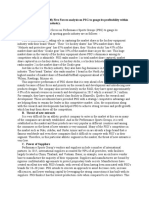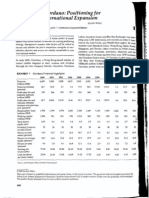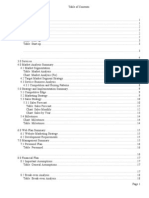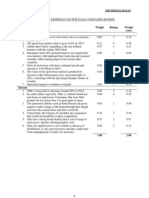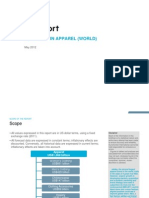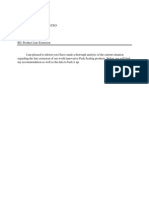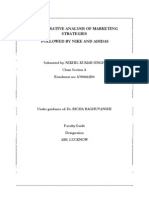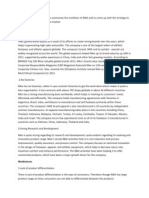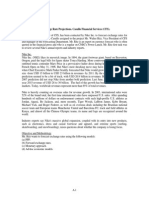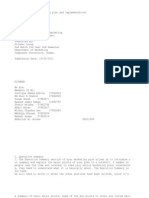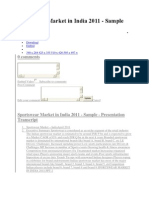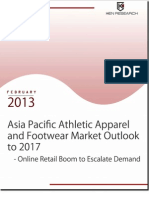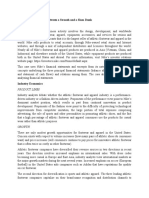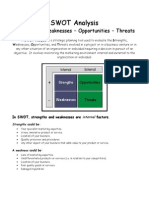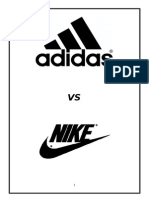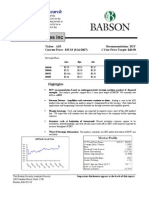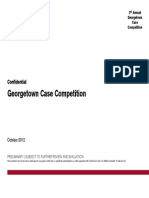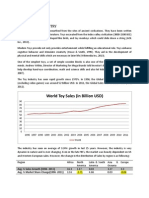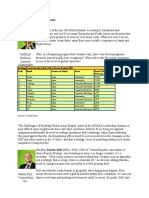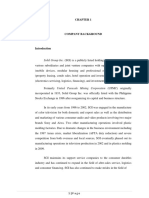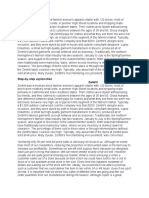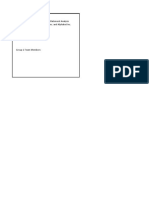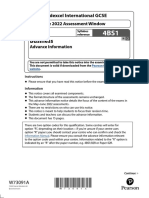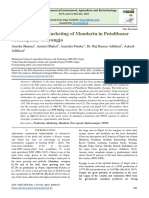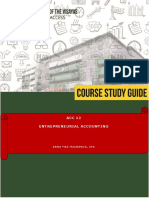China Sportswear: Sporting Challenge
China Sportswear: Sporting Challenge
Uploaded by
Kylie ChanCopyright:
Available Formats
China Sportswear: Sporting Challenge
China Sportswear: Sporting Challenge
Uploaded by
Kylie ChanOriginal Title
Copyright
Available Formats
Share this document
Did you find this document useful?
Is this content inappropriate?
Copyright:
Available Formats
China Sportswear: Sporting Challenge
China Sportswear: Sporting Challenge
Uploaded by
Kylie ChanCopyright:
Available Formats
Consumer & Retail Textiles, Apparel & Luxury Goods
abc
Global Research
Competitive pressure from intl brands is rising but near term impact is limited Sportswear consumption is rising and growth opportunities still exist Overweight Anta and Xtep. Neutral on Li Ning and Dongxiang
China Sportswear
Sporting challenge
Ratings summary
Market cap Ticker FYE Rating* (USDm) 2020.HK 3818.HK 2331.HK 1368.HK Dec OW(V) Dec N(V) Dec N(V) Dec OW 4,543 3,278 3,513 1,617 Price Target price P/E FD-EPS (HKD) ___ (HKD)___ (x) growth 3-Aug Old New FY11E FY11E 14.1 4.5 26.0 5.8 11.2 n/a 25.5 n/a 18.0 4.7 29.0 6.8 16.5 12.2 18.6 12.1 24% 12% 18% 24%
Company Anta Dongxiang Li Ning Xtep
Changing competitive environment. The Chinese sportswear sector is entering a new phase as industry players are changing their business strategies to compete for market share. International brands are looking to create new product offerings to suit the mass market in lower tier cities. Domestic brands, on the other hand, are placing more emphasis on branding strategy, aiming to further strengthen brand equity and move up the value chain. The impact. While international brands pose a competitive threat to the domestic brands, the impact should be minimal in the near term as it will take time for them to fully establish their distribution network in lower tier cities and broaden their lower priced product offerings. In the long run, we believe all domestic brands will be affected, but the stronger ones can mitigate the impact by gaining market share from weaker brands. Growth opportunities. Despite the looming competition, sportswear consumption is still in a growth phase, especially in the mass mid-end market and lower tier cities. China is at a stage in the macro cycle that wealth will likely trickle down to the lower income group, which in turn would favour mass market consumption, including sporting goods. Top picks - Anta Sports (2020.HK) and Xtep (1368.HK). Anta is the second largest Chinese sportswear brand company in China. Stronger brand recognition and better economies of scale should enhance Antas margins and earnings momentum. We also like Xtep given growing recognition of its brand in the mass mid-end market, differentiated branding strategy, strong balance sheet and undemanding valuation. In this report, we initiate coverage of China Dongxiang and Xtep and Christopher Leung assumes coverage of Anta and Li Ning.
Priced as of 3 August 2010. OW = Overweight and N = Neutral. Source: Company reports and HSBC estimates
4 August 2010
Christopher K Leung* Analyst The Hongkong and Shanghai Banking Corporation Limited +852 2996 6531 christopher.k.leung@hsbc.com.hk
View HSBC Global Research at: http://www.research.hsbc.com *Employed by a non-US affiliate of HSBC Securities (USA) Inc, and is not registered/qualified pursuant to FINRA regulations Issuer of report: The Hongkong and Shanghai Banking Corporation Limited
Disclaimer & Disclosures This report must be read with the disclosures and the analyst certifications in the Disclosure appendix, and with the Disclaimer, which forms part of it
Vote for the World's Local Broker www.asiamoney.com/polls
Consumer & Retail Textiles, Apparel & Luxury Goods 4 August 2010
abc
China Sportswear Selected Comparison Company Ticker FY End # of Outlets - 2008 - 2009 - 2010e - 2011e - 2012e Avg Sales Per store (RMBm) - 2008 - 2009 - 2010e - 2011e - 2012e Sales Breakdown (2009) - Footwear - Apparel - Accessories Revenue growth - 2008 - 2009 - 2010e - 2011e - 2012e Net profit growth - 2008 - 2009 - 2010e - 2011e - 2012e Gross margin - 2008 - 2009 - 2010e - 2011e - 2012e EBIT margin - 2008 - 2009 - 2010e - 2011e - 2012e Net margin - 2008 - 2009 - 2010e - 2011e - 2012e A&P Expenses (% of sales) - 2008 - 2009 - 2010e - 2011e - 2012e Net-cash/(Debt) (RMB M) - 2008 - 2009 - 2010e - 2011e - 2012e Acct Receivable Days - 2008 - 2009 - 2010e - 2011e - 2012e Li Ning (2331.HK) Dec Li Ning Brand 6,245 7,249 8,000 8,700 9,300 1.1 1.1 1.2 1.2 1.4 42% 47% 11% 54% 25% 16% 19% 24% 52% 31% 15% 18% 20% 48.1% 47.3% 47.0% 46.9% 47.1% 13.4% 14.5% 14.3% 14.2% 13.9% 10.8% 11.3% 11.1% 11.1% 10.8% 17.5% 15.4% 15.5% 15.5% 16.0% 286 1,004 1,479 2,412 3,034 48 47 47 46 47 Anta (2020.HK) Dec Anta Brand 5,667 6,591 7,241 7,891 8,541 0.9 0.9 1.0 1.0 1.1 56% 41% 3% 55% 27% 22% 21% 22% 66% 40% 21% 24% 23% 40.0% 42.1% 42.6% 44.5% 45.4% 20.1% 23.7% 24.5% 25.9% 26.5% 19.3% 21.3% 21.2% 21.8% 21.9% 13.8% 12.7% 13.5% 13.8% 14.0% 3,493 4,007 4,081 4,963 5,846 39 33 34 36 36 Dongxiang (3818.HK) Dec Kappa Brand 2,808 3,511 4,161 4,811 5,461 1.2 1.1 1.1 1.1 1.1 20% 76% 4% 94% 20% 18% 14% 16% 67% 19% 12% 12% 10% 58.5% 60.4% 61.2% 62.0% 62.2% 40.1% 42.7% 41.6% 41.7% 40.2% 41.2% 36.8% 34.8% 34.1% 32.2% 7.7% 7.4% 8.5% 8.9% 9.9% 6,064 6,529 7,248 7,907 8,536 28 34 36 36 36 Xtep (1368.HK) Dec Xtep Brand 5,056 6,103 6,903 7,703 8,503 0.6 0.6 0.6 0.7 0.7 46% 53% 1% 110% 24% 22% 18% 17% 129% 27% 14% 24% 23% 37.1% 39.1% 39.9% 41.2% 42.3% 20.6% 19.8% 20.6% 21.7% 22.8% 17.7% 18.3% 17.2% 18.0% 18.9% 9.1% 11.8% 11.8% 12.0% 12.0% 2,013 2,498 2,286 2,715 2,640 48 54 55 55 56 361 Degrees (1361.HK) Jun 361 Brand 4,632 6,055 n/a n/a n/a 0.3 0.6 n/a n/a n/a 47% 51% 2% 253% 162% 26% 23% 21% 681% 253% 36% 21% 22% 26.4% 34.6% n/a n/a n/a 15.4% 21.4% 24.1% 24.5% 25.7% 13.6% 18.3% 19.8% 19.4% 19.5% 6.0% 8.4% n/a n/a n/a -2 1,803 n/a n/a n/a 86 103 n/a n/a n/a Peak Sport (1968.HK) Dec Peak Brand 5,179 6,206 n/a n/a n/a 0.5 0.5 n/a n/a n/a 45% 52% 3% 101% 52% 30% 29% 21% 126% 67% 28% 30% 19% 32.7% 37.5% n/a n/a n/a 20.4% 23.2% 21.4% 21.4% 22.1% 18.4% 20.3% 19.9% 20.1% 19.9% 7.5% 11.3% n/a n/a n/a 286 1,988 n/a n/a n/a 74 70 n/a n/a n/a
Source: Datastream, HSBC estimates, I/B/E/S estimates for non-rated (NR) companies.
Consumer & Retail Textiles, Apparel & Luxury Goods 4 August 2010
abc
China Sportswear Selected comparison (Ranked by 1M share price movement) Company Peak 361 Degrees Pou Sheng Li Ning Anta Xtep Dongxiang Ticker FYE Rating* 1968.HK Dec 1361.HK Jun 3813.HK Sept 2331.HK Dec 2020.HK Dec 1368.HK Dec 3818.HK Dec NR NR NR N(V) OW(V) OW N(V) Mkt-Cap Price _________ P/E _____ ___ FD-EPS Growth ___ _____ P/B _____ _____ROE_____ ___Share Price Mvmt __ USDm (HKD) FY10e FY11e FY12e FY10e FY11e FY12e FY10e FY11e FY10e FY11e 1 mth 3 mth 6 mth 1,562 1,637 569 3,513 4,543 1,617 3,278 5.8 6.2 1.0 26.0 14.1 5.8 4.5 13.1 13.1 11.4 22.0 20.5 14.9 13.7 10.0 10.8 11.4 18.6 16.5 12.1 12.2 8.4 8.9 6.4 15.5 13.5 9.8 11.1 8% -2% n/a 15% 21% 14% 12% 32% 21% 18% 24% 24% 12% 19% 21% 78% 20% 23% 23% 10% 3.9 n/a 0.7 7.1 5.4 3.4 2.7 3.1 n/a 0.7 4.8 6.7 7.8 7.7 25% 30% 4% 36% 28% 24% 21% 26% 30% 7% 34% 30% 26% 22% 14% 12% 10% 2% 1% -8% -11% -6% 4% -16% -14% 0% -3% -17% 18% 12% -30% 2% 32% 13% -14%
Note: Priced as of 3 August 2010. OW = Overweight, N = Neutral, NR = Non-Rated. Source: Datastream, HSBC estimates, I/B/E/S estimates for non-rated (NR) companies.
Consumer & Retail Textiles, Apparel & Luxury Goods 4 August 2010
abc
Contents
Industry dynamics
Entering a new phase Nikes China strategy Growth opportunities Market segmentation Critical factors Sales outlook
5
5 5 6 7 8 9
Company highlights
Anta Sports (2020) China Dongxiang (3818) Li Ning (2331) Xtep (1368)
11
12 20 29 39
Disclosure appendix Disclaimer
48 51
Consumer & Retail Textiles, Apparel & Luxury Goods 4 August 2010
abc
Industry dynamics
Competition has intensified and companies are changing their business strategies to compete for market share International brands, ie Nike and Adidas, are moving into lower tier cities and putting pressure on domestic brands Despite looming competition, sportswear consumption in China is still at an expansionary stage with growth opportunities
Entering a new phase
We believe the Chinese sportswear sector is entering a new phase as industry players are changing their business strategies to compete for market share. International brands are looking to create new product offerings that suit the mass market in lower tier cities. Domestic brands, on the other hand, are placing more emphasis on branding strategy, aiming to further strengthen brand equity and move up the value chain. International brands could pose a competitive threat to the domestic brands when they shift towards the lower tier cities with lower priced products. In the near term, we believe the impact on the domestic brands will be limited as it will take time for the international brands to fully establish their distribution network in lower tier cities and to broaden their lower priced products offerings. In the long run, all domestic brands will be affected but stronger ones will prevail at the expense of weaker brands. Chinese consumers have low brand loyalty, especially in lower tier cities, and we think the biggest challenge for the international brands in moving into the lower tier cities is to ensure their
expansion will not negatively affect their perceived high-end brand image. On the other hand, for domestic brands, we think the key success factors in this new phase are to improve the perceived product performance along with building and/or maintaining the brand.
Nikes China strategy
Nike recently said that it is moving more aggressively into the lower tier cities in China and is looking at pricing options and product introductions that may be at the lower end of the Nike product range, as well at different opportunities with some of the other brands in the portfolio. Below are some of our thoughts on Nikes strategy in China. We believe the expansion into lower tier cities takes time and we do not think we will see any large scale roll-out of lower priced products in the lower tier cities until 2012. To retain its high-end image, we think Nike will maintain its high-end price positioning and the new lower priced products will still be priced at a premium to the domestic brands. In addition, we also think Nike may introduce
Consumer & Retail Textiles, Apparel & Luxury Goods 4 August 2010
abc
a sub-brand or a new brand to penetrate the lower tier cities. Based on our store visits in five first and second tier cities last month (Tianjin, Xian, Taiyuan, Chongqing, and Changsha), the retail ASP for Nike running shoes is around RMB528/pair and it is about 56% higher than that of Li Ning. If Nikes lower priced products are at the RMB400 level, the price difference would be reduced to around 18%.
Selected Comparison Running shoe avg. retail price in China Brand Nike Adidas Li Ning Anta Xtep Peak 361 Degrees Xdlong
Source: HSBC estimates
Growth opportunities
We believe the Chinese sportswear market is still in a growth phase, especially in the mass market and lower tier cities where the growth is generally faster than the mature first and second tier cities. China is at a stage in the macro cycle that wealth will likely trickle down to a lower income group and in turn would favour mass market consumption, including sporting goods. We forecast the size of Chinas sportswear market will grow from RMB74bn in 2009 to RMB150bn in 2014e, representing an annual CAGR of 19%. Growth in the sportswear market slowed from 36% in 2008 to 11% in 2009 due to inventory overhang after the Beijing Olympic Games and the weak consumption environment after the financial crisis. However, we believe rising income and urbanization will continue to propel sportswear consumption in the next few years.
China sportswear market size, 2009-13e
Running shoe retail ASP (After Discount) RMB528/pair RMB510/pair RMB339/pair RMB265/pair RMB219/pair RMB213/pair RMB196/pair RMB185/pair
Given Nikes distributors are mainly focused on the first and second tier cities, Nike may need to provide higher financial incentives to their distributors for their expansion into the lower tier cities. Belle (1880.HK) and Pou Sheng (3813.HK) are the two largest listed distributors for Nike in China and we think they may benefit from Nikes move towards the mass market. Nike may also need to find new suppliers as the existing suppliers incur higher overhead costs and may not want to allocate the existing resources and capacity to lower margin orders. All domestic brands will be affected as Nike may erode their customer base. However, we think the strong domestic brands, ie Li Ning and Anta, etc) could mitigate the impact by gaining market shares from other smaller brands that underinvested in product development and brand equity.
Rmb in billions
200 150 100 50 2009 2010E 2011E 2012E 2013E
20% 15% 10% 5% 0% Yo Y Growth
China Sportsw ear Market Size Annual Grow th Rate
Source: ZOU Marketing, HSBC estimates
Chinas urbanization rate could top 65% by the end of 2030e and eventually reach 70-80% by the middle of the century, which means there is still another 25-35ppts room to go from the current level, according to our China strategist, Steven Sun. In addition, the renewed policy focus on income distribution reform in China could also spur consumption further. The minimum wage is going up 10-30% across China this year and we believe this is just the
Consumer & Retail Textiles, Apparel & Luxury Goods 4 August 2010
abc
beginning. The State Council stated its intention to double labour compensation during the 12th Five-Year Plan period, representing a 15% CAGR in labour compensation. This, then, would fuel rising discretionary income and support growing demand for many products, including sports wear.
Government intends to double labour comp, 2011-2015e
Based on our analysis of 15 sportswear companies, we found the high-end segment accounted for 35% of total market size in 2009 and the mid-end made up 41%, followed by the low-end segment at 24%. With rising income and urbanization in China, we believe the high-end and mass mid-end segments will continue to see faster growth over the next few years and the low-end segment will continue to shrink. Our estimates show that Nike has the biggest market share in China (16% in 2009), followed by Adidas (13%), Li Ning (11%), and Anta (8%). Other smaller brands (such as Deerway, Umbro, Mizuno, and Guirenniao) made up 17% of the total market size in 2009. In the past few years, dominant brands have been gaining market shares from the smaller brands and we think this consolidation trend will continue over the next few years as smaller players that are under invested in A&P and R&D may lose market share to the dominant brands.
China sportswear market shares, 2009
80 60 40 20 -
Labour com p. (Rm b trn) N orm inal GDP R atio
47% 46% 45% 44% 43% 42% 41% 40% 39%
2010e 2011e 2012e 2013e 2014e 2015e
Source: HSBC, State Council (assuming nominal GDP CAGR=12% vs 15% CAGR for labour compensation as implied by 12th Five Year Plan.
Market segmentation
The China sportswear market can be divided into three segments: The high-end segment is largely dominated by foreign brands and their retail price for a pair of running shoe ranges from RMB6001,000. The mass mid-end and low-end segments are dominated by the domestic brands. In the mass mid-end segment, the general retail price for a pair of running shoe ranges from RMB200-400. For the low-end segment, the pricing is below RMB200 per pair.
Others Qiaodan Yeli 5% 3% Xdlong 3% Fly ke 1%Erke 3% Meike 1% Xtep 5% Peak 361o 4% 5% 17%
Adidas 13% Nike 16%
Li Ning 11% Kappa 5% Anta 8%
Source: ZOU Marketing, Company Reports, and HSBC estimates
Consumer & Retail Textiles, Apparel & Luxury Goods 4 August 2010
abc
Critical factors
For domestic brands to continue gaining market share, we believe effective branding strategies and strong financial position are two critical factors. For the six Hong Kong listed Chinese sportswear companies, they are generally financially healthy, with high net-cash position and positive cash flow. The strong financial performance reflected their good operating performance in the past years and the new capital from the equity market. We summarize below the net cash and FCF of the six HK listed sportswear companies in 2009.
Net-cash and FCF comparison, 2009 (RMBm) Company Net cash FCF
around 10% of sales over the next two years. Anta has also recently signed Kevin Garnett as its second endorsed NBA player and we think its A&P spending will also be higher over the next few years. In the chart below, we summarize the A&P spending of the six Hong Kong listed sportswear companies in 2009. The increase in A&P spending is likely to have a negative impact on profitability, while a companys ability to raise product prices and/or achieve economies of scale would be critical. In the past few years, the Chinese sportswear brands (with the exception of Dongxiang) have expanded their operating margins through gross margin expansion and/or operating leverage.
EBIT margin comparison, 2006-09 Company Ticker 2006 2007 2008 2009
Li Ning Anta Dongxiang Xtep Peak 361 Degrees
Source: Company reports
1,004 4,007 6,529 2,498 1,988 1,803
1,039 1,157 1,319 794 165 403
In order to improve brand equity and product offering, we think most sportswear companies will increase their spending on Advertising and Promotion (A&P) and Research and Development (R&D) spending over the next few years. For example, Dongxiang (3818.HK) is increasing its A&P expenses from 7.4% of sales in 2009 to
Li Ning Anta Dongxiang Xtep Peak 361 Degrees
Source: Company reports
2331.HK 2020.HK 3818.HK 1368.HK 1968.HK 1361.HK
12% 12% 45% 12% 18% 5%
13% 16% 42% 20% 17% 8%
13% 20% 40% 21% 20% 15%
14% 24% 43% 20% 23% 21%
A&P expense comparison, 2009
1,400 1,200 A&P Expenses (Rmb M) 1,000 800 600 400 200 Li Ning
Source: Company reports
Anta
Xtep
Peak
Dongx iang
361 Degrees
Consumer & Retail Textiles, Apparel & Luxury Goods 4 August 2010
abc
Sales outlook
Dongxiang recently announced its retail samestore-sales (SSS) dropped from +4% in 1Q 2010 to only +0.4% in 2Q-2010 and its retail inventory also deteriorated to 5.2x. Management attributed the weak performance to the poor weather (ie: heavy rains in Central and Southwest China in May and June). While it is alarming to see such a big decline in the second quarter, we think this is not an industry wide issue as Kappa products are more cyclical than others and this seems like a companyspecific issue. For 2H 2010, we expect most sportswear companies will report improvement in their retail SSS growth, mainly due to a lower comparison base from last year. However, for Li Ning, there is risk that its SSS in 3Q 2010 could be below our expectation as the company has recently changed its logo and its distributors are now offering bigger discounts to clear the old logo inventories. Based on our store visits in Shenzhen, we noted Li Ning stores are offering 30-40% discounts on old logo products.
SSS growth for Anta, Dongxiang, Li Ning, and Xtep Yr to 31 Dec Anta Dongxiang Li Ning Xtep
Outlet additions Anta, Dongxiang, Li Ning, and Xtep Year to 31 Dec # of outlets (% YoY) 2009A 2010E 2011E 2012E Anta Dongxiang Li Ning Xtep
16% 10% 9% 8%
25% 19% 16% 14%
16% 10% 9% 7%
21% 13% 12% 10%
Source: Company reports and HSBC estimates
Based on our analysis of six sportswear companies in China, we noted most of their stores are located in the eastern and northern China regions and their exposure in the western and southern China regions are lower. With the government planning to speed up economic development in cities or city circles in the inland and western parts of China, we believe the domestic brands will focus more on their network expansion in western China.
Sportswear outlets breakdown by region Region Adidas Anta DX* Peak Xtep 361*
East South West North
35% 14% 16% 35%
38% 21% 14% 28%
33% 14% 17% 36%
30% 21% 18% 31%
41% 12% 18% 30%
28% 15% 19% 39%
* DX = Dongxiang and 361 stands for 361 Degrees. Note: For Anta and Xtep, the data was from 2008 annual report. For Kappa, Peak, and 361, the data was based on 2009 annual report. For Adidas, the data was based on its China website. Source: Company reports, websites, and HSBC estimates
1Q09a 2Q09a 3Q09a 4Q09a 1Q10a 2Q10a/e 3Q10e 4Q10e
+7-9% +7-9% +5-7% +7-9% +10-12% +7-9% +9% +7%
+6% Up Single Digit +2% Down Single Digit -11% -8% +1% +3.8% +4% +0.4% +5% +4% +5% +4% +8% +9%
+2% +5% +6% +8-9% +5% +8-9% +8% +5%
All domestic sportswear brand companies have completed their sales fairs for 2010 and total order values for Anta, Dongxiang, Li Ning and Xtep increased 17-23%. For 2011, we are looking for order book growth between 16-18%.
Order book growth for Anta, Dongxiang, Li Ning and Xtep Yr to 31 Dec Anta Dongxiang Li Ning Xtep
Source: Company reports and HSBC estimates
Sales volume growth from store expansion by distributors will continue to be one of the key drivers of revenue growth for most of the sportswear companies over the next two years. The table below is a summary of our forecast for the outlet additions on Anta, Dongxiang, Li Ning and Xtep.
1Q-FY10 2Q-FY10 3Q-FY10 4Q-FY10 Average 1Q-FY11 2Q-FY11 3Q-FY11 4Q-FY11 Average
18% 16% 18% 25% 19% 17% 19% 17% 18% 18%
17% 22% 22% 23% 21% 14% 15% 18% 18% 16%
12% 15% 20% 20% 17% 18% 18% 16% 16% 17%
22% 20% 23% 25% 23% 18% 20% 18% 17% 18%
Source: Company reports and HSBC estimates
Consumer & Retail Textiles, Apparel & Luxury Goods 4 August 2010
abc
This page has been intentionally left blank.
10
Consumer & Retail Textiles, Apparel & Luxury Goods 4 August 2010
abc
Company highlights
11
Consumer & Retail Textiles, Apparel & Luxury Goods 4 August 2010
abc
Anta Sports (2020)
Despite rising tax rate, net margin should remain steady due to higher gross margin and larger economies of scale 23% earnings CAGR over 2010-12e. Our estimates for 2010-12 are 5-12% above consensus forecast Upgrade to OW(V) on higher earnings expectations and raise target price to HKD18, representing 29% potential return
Investment summary
We upgrade Anta Sports (2020.HK) to an Overweight (V) rating from Neutral (V) as we think the stock could be re-rated on higher earnings expectations. We also raise our target price to HKD18.00 from HKD11.20 and revise up our 2011-12 earnings forecast by 23-25% as we believe there is potential upside for the groups margins due to lower wholesale discounts offered to its distributors and better economies of scale. We also introduce our 2012 earnings forecast and project Anta will achieve 23% earnings CAGR over 2010-12. Our 2010-12 earnings estimates are 5-12% above consensus.
Focusing on mass mid-tier market
Stronger brand recognition
Anta is focused at the mass mid-tier market (pricing between RMB200-400) and we believe it will continue to be the groups core focus in the next few years. Anta acquired the FILA brand business from Belle in September 2009 to tap the potential of the high-end market and this suggested that the company has no plans to elevate its core Anta brand to the high-end market.
Anta is the second largest Chinese sportswear brand company in China. One of its competitive advantages is that its brand is increasingly recognised by the mass mid-tier market, in our view. Since Anta aligned with the Chinese Olympic Committee (COC) in 2009, it has further raised brand awareness and perceived value through various sponsorships and new product offerings. For example, Anta sponsored outfits for the Chinese sport delegates in major international competitions and launched new COC apparel collections in its retail stores to remind consumers that it is the official partner of the Chinese Olympic Committee. In addition, it has also launched new sport shoe technology called AJelly that has anti-compression and resilience functions to differentiate its product offerings. Anta also recently announced that it has signed Kevin Garnett as its second endorsed NBA player to enhance the groups brand image in basketball.
12
Consumer & Retail Textiles, Apparel & Luxury Goods 4 August 2010
abc
FILA could be profitable in 2011
Anta - FILA Store in Xiamen, China
We expect the FILA operation will incur a small loss this year. However, we think it will be profitable in 2011 on bigger scale and Anta may accelerate its stores expansion for FILA after revamping the product offerings. Management currently targets to have 300 FILA stores in China by end-2010 and we expect it will increase to 800 in 2011 and 1,600 in 2012. We forecast the FILA operation will post a small profit of RMB36m in 2011 and an operating margin of 12%.
Anta Key Assumptions for FILA Brand Business FYE Dec (RMBm) Revenue Cost of sales Gross profit Gross margin Operating cost EBIT EBIT margin # of stores in China 2009e/e 92 -46 46 50% -88 -42 n/a 50 2010e 71 -35 35 50% -55 -20 n/a 300 2011e 300 -150 150 50% -114 36 12% 800 2012e 743 -371 371 50% -245 126 17% 1,600
Source: HSBC Source: HSBC
Anta - FILA Store in Xiamen, China
Source: Company R=reports and HSBC estimates
Anta - FILA Store in Xiamen, China
We visited Antas new FILA store in Xiamens pedestrian zone and noted its product mix is mainly dominated by apparel products, while the price of both footwear and apparel is much higher than other local brands, eg the retail price of a polo shirt is RMB288-330 and RMB500-700 for a pair of sports shoes.
Anta - FILA Store in Xiamen, China
Source: HSBC
Source: HSBC
13
Consumer & Retail Textiles, Apparel & Luxury Goods 4 August 2010
abc
Earnings outlook
We forecast Anta will achieve 23% earnings CAGR over 2010-12e on 22% revenue growth. Gross margin should increase from 42.1% in 2009 to 45.4% in 2012, largely driven by lower wholesale discounts given to distributors and better economies of scale. We also expect the groups EBIT margin to expand from 23.7% in 2009 to 26.5% in 2012 on the back of the gross margin expansion and lower operating costs due to efficiency gains. That said, we expect net margin to be flattish at the 21-22% level over next few years due to a higher effective tax rate. We forecast the groups effective tax rate will rise from 14% in 2009 to19% in 2010.
Anta - HSBC vs Consensus Yr to 31 Dec FY10e FY11e FY12e
Business analysis
Anta has three major product lines: sports footwear, sports apparel and sports accessories. In 2009, sports footwear and apparel accounted for 56% and 41% respectively of its business. In addition to the ANTA brand, the company also owns the Fila trademark in China, which it intends to use to tap the potential of the high-end sportswear market. The companys core ANTA brand targets the mass market for the 14-29 years old age group. The ANTA brand has established high brand awareness among young consumers and is positioned as a trendy professional sportswear brand. In the past few years, Anta has achieved strong growth, with sales CAGR of 40% and earnings CAGR of 53% between 2007 and 2009, thanks to rapid retail network expansion and margins improvement.
ANTA brand
Revenue EBIT Net profit
-1% 7% 5%
-3% 8% 9%
-1% 5% 12%
Source: Bloomberg and HSBC estimates
1H10 earnings preview
The company is scheduled to report its 1H 2010 results in mid August 2010 and we are looking for earnings to rise 20% y-o-y on 21% revenue growth.
Anta 1H10 earnings preview Year to 31 Dec (RMBm) Revenue COGS Gross Profit Other income Selling & Distribution Admin expenses Other gain/losses Opg Profit Finance income PBT Tax Net Profit 1H09 2,817 -1,648 1,169 14 -396 -105 0 683 26 709 -101 608 1H10e 3,406 -1,948 1,458 18 -511 -119 -1 845 28 873 -141 733
The ANTA logo is designed in the shape of English letter A slanting to the left as if it is accelerating into motion. The red colour represents youth and energy and the Chinese slogan means keep moving. In addition to the performance-based series, the company launched the Sports Lifestyle series and Kids sportswear series in 2008. In terms of price positioning, Antas price point is currently about 20-30% lower than Li Ning and 50-65% below the high-end international brands such as Nike and Adidas. Yet its ASP is gradually moving up, driven by increase in consumers income and strengthening of brand image. We expect Anta will continue to enhance its brand equity through effective promotions and sponsorships. In June 2009, the company entered into a strategic alliance agreement with the Chinese Olympic Committee (COC) to sponsor Chinese athletes to wear ANTA sports apparel to
% YoY 21% 18% 25% 25% 29% 14% n/m 24% 7% 23% 40% 20%
Source: Company reports and HSBC estimates
14
Consumer & Retail Textiles, Apparel & Luxury Goods 4 August 2010
abc
11 international competitions from 2009 to 2012, including the London 2012 Olympic Games. In addition, Anta has sponsored various athletes to endorse its products, including Kevin Garnett and Luis Scola (NBA players), Zheng Jie (Chinese female tennis player), and various CBA (China Basketball Association) players.
ANTA A-Jelly Shoes ad
The ANTA brand products are sold on a wholesale basis to more than 50 exclusive distributors who will distribute to authorized ANTA retail outlets. Each year the company organizes four trade fairs for distributors to place orders for the next seasons products. After receiving the orders from sales fairs, the company will determine the raw materials requirements and place orders with suppliers. Raw materials are purchased in bulk to enjoy more favourable purchase prices. The company will also order commonly used raw materials in advance in anticipation of future sales orders, which allows better cost control on sales.
ANTA sport store
Source: HSBC
An integrated business model
Anta adopts a vertically integrated business model for the ANTA branded sportswear business where the company engages in design to marketing of its products. The footwear and apparel production bases are located in Fujian province where approximately 42% of footwear and 17% of apparel sold were manufactured in-house in 2009. The majority of the raw materials are sourced from suppliers located in Fujian, which are logistically convenient to Antas production facilities. This also helps to lower the procurement costs. Part of the production is outsourced to external contract manufacturers through two types of arrangements: purchasing from OEMs and subcontracting. Anta does not enter into long-term agreements with contract manufacturers but enters into separate purchase contracts for different products.
Source: HSBC
ANTA store
Source: HSBC
15
Consumer & Retail Textiles, Apparel & Luxury Goods 4 August 2010
abc
Financial analysis
Revenue outlook
We forecast Anta will achieve 22% revenue CAGR over 2010-12, largely driven by the ANTA branded business. Anta recently completed all four sales fairs for 2010 and we estimate total order book values were up 19% y-o-y. For 2011, we are looking for total order book values to rise 18% y-o-y, driven by 9% volume growth from new store additions by its distributors and 7% retail same-store-sales growth.
Order book growth for Anta, Dongxiang, Li Ning and Xtep Yr to 31 Dec Anta Dongxiang Li Ning Xtep
sales floor area also surged 23% y-o-y to 727,703 square meters. In terms of sales volume, footwear was up 8.1% y-o-y to 10.3m pairs and apparel surged 24% y-o-y to 15.2m. In addition to the Anta sport products, the company also launched two new collections in 2008 - Anta kids and Anta lifestyle. Anta kids product is mainly targeted at children aged 9-14 years old and the retail price point is about RMB150-200 for footwear and RMB80-150 for apparel. As at end-2009, Anta had 228 Anta kids stores in China. Management said they plan to add 70 new Anta kids stores in 2010.
ANTA kids store
1Q-FY10 2Q-FY10 3Q-FY10 4Q-FY10 Average 1Q-FY11 2Q-FY11 3Q-FY11 4Q-FY11 Average
18% 16% 18% 25% 19% 17% 19% 17% 18% 18%
17% 22% 22% 23% 21% 14% 15% 18% 18% 16%
12% 15% 20% 20% 17% 18% 18% 16% 16% 17%
22% 20% 23% 25% 23% 18% 20% 18% 17% 18%
Source: Company reports and HSBC estimates Source: HSBC
SSS growth for Anta, Dongxiang, Li Ning, and Xtep Yr to 31 Dec Anta Dongxiang Li Ning Xtep
Anta lifestyle product is targeted at customers aged 15-28 years old and the retail price point is about RMB150-250 for footwear and RMB100 for apparel. The average store size for Anta lifestyle is around 60-70 sq m and that is 35-44% smaller than Anta sport store. For 2010, Anta plans to add 200-300 Anta lifestyle stores.
Anta Retail network in China
1Q09a 2Q09a 3Q09a 4Q09a 1Q10a 2Q10a/e 3Q10e 4Q10e
+7-9% +7-9% +5-7% +7-9% +10-12% +7-9% +9% +7%
+6% Up Single Digit +2% Down Single Digit -11% -8% +1% +3.8% +4% +0.4% +5% +4% +5% +4% +8% +9%
+2% +5% +6% +8-9% +5% +8-9% +8% +5%
Source: Company reports and HSBC estimates
Retail network expansion is one of the key growth drivers of revenue growth. As at end-2009, the company had a total of 6,591 Anta sport outlets in China. For 2010, management aims to add around 600-700 new outlets. Our model currently assumes it will add 650 new outlets in each of 2010, 2011, and 2012. In 1Q 2010, Anta added 136 new Anta sport outlets, bringing the total number to 6,727. Total
Year to 31 Dec Anta sport stores % Chg. # of New Stores Average # of stores % Chg. Anta kids stores - Chg Anta lifestyle stores - Chg
2008a 5,667 20% 951 5,192 18% 81 n/a 33 n/a
2009a 6,591 16% 924 6,129 18% 228 147 343 310
2010e 7,241 10% 650 6,916 13% 298 70 593 250
2011e 7,891 9% 650 7,566 9% 368 70 843 250
2012e 8,541 8% 650 8,216 9% 438 70 1093 250
Source: Company reports and HSBC estimates
16
Consumer & Retail Textiles, Apparel & Luxury Goods 4 August 2010
abc
Margins outlook
Higher gross margin
Efficiency gains
Despite key raw material costs, such as cotton and rubber, having surged 28-39% since September 2009, we think Anta should able to continue to expand its gross margin in the next few years on change in ASP. In addition, the company has its in-house shoe sole production factory in Anhai, Fujian and we think it could lower part of the product costs through more in-house production. For reference, the shoe sole output increased from 9.3m pairs in 2008 to 12.7m pairs in 2009. Furthermore, pricing power of brand owners (e.g. Nike, Anta, Li Ning) is generally stronger than for manufacturers (e.g. Yue Yuen) and we think Anta may not need to fully absorb the increase in raw material costs. For 2010, we expect the groups gross margin to increase 0.5ppt to 42.6%, mainly driven by the improvement in the footwear gross margin. For 2011, we expect the groups gross margin to increase by 1.8ppt to 44.5% in 2012e on higher ASP and lower cost increase. As Anta has further strengthened its brand recognition through the COC sponsorship, we think the company is likely to reduce its wholesale discount to its distributors by 0.5ppt in 2011. By product segment, we expect footwear gross margin will rise from 45.5% in 2010 to 47.1% in 2011, largely driven by a 5% increase in wholesale price. We also expect apparel margin will increase to 40.3% in 2011 from 38.4% in 2010.
Anta Gross margin breakdown, 2008-12e Year to 31 Dec 2008a 2009a 2010e 2011e 2012e
In addition to our expectation of gross margin improvement, we think there is room for lower operating expenses in the next two years due to efficiency gains. The company is constructing a new operational centre in Xiamen and it is planned for completion in early 2011. Management indicated the new operational centre not only provides a better working environment, it can also enhance the groups operating efficiency.
But higher tax rate
While we expect the groups gross and EBIT margin will continue to expand, the positive impact on the bottom line is likely be mitigated by effective tax rate. We expect the groups effective tax rate will rise from 14% in 2009 to 16% in 2010 and 18% in 2011, and 19% in 2012 due to expiration of tax incentives, Overall, we expect the groups net margin to remain steady at the 2122% level.
Anta Key margin assumptions Year to 31 Dec 2008a 2009a 2010e 2011e 2012e
Gross margin EBITDA margin EBIT margin Net margin Effective tax rate
Key cost items A&P (% of sales) R&D (% of sales) Staff (% of sales) Effective tax rate
40.0% 21.0% 20.1% 19.3% 7.0% 13.8% 3.0% 3.7% 7.0%
42.1% 24.7% 23.7% 21.3% 13.6% 12.7% 3.0% 4.7% 13.6%
42.6% 25.5% 24.5% 21.2% 16.2% 13.5% 2.5% 4.5% 16.2%
44.5% 26.9% 25.9% 21.8% 18.1% 13.8% 2.5% 4.3% 18.1%
45.4% 27.4% 26.5% 21.9% 19.3% 14.0% 2.5% 4.1% 19.3%
Source: Company reports and HSBC estimates
Footwear Apparel Accessories
41.3% 38.0% 41.2%
44.4% 39.0% 41.4%
45.5% 38.4% 41.4%
47.1% 40.3% 41.4%
47.7% 41.4% 41.4%
Source: Company reports and HSBC estimates
17
Consumer & Retail Textiles, Apparel & Luxury Goods 4 August 2010
abc
Valuation
We use P/E to value Anta as we believe it can better reflect the companys earnings momentum. We believe using the groups historical P/E to determine our target multiple for Anta is appropriate given the Chinese sportswear sector is becoming more competitive and the industry growth rate in the next few years is unlikely to be as strong as the levels seen in 2004-08. Our target price of HKD18 is based on a 22x oneyear forward PER and it is derived from a 35% premium to the groups historical forward PER average since July 2007. We believe such premium is warranted by steady earnings growth, rising ROE (from 26% in 2009 to 28% in 2010 and 30% in 2011) and its strong brand positioning in the mass mid-end market. On a PEG basis, our target price of HKD18.0 would translate into a PEG of 1x based on our 23% earnings CAGR forecast for 2010-12e. Under HSBCs research model, our target price suggests a potential return of 29% (including 3% dividend yield), which is above the Neutral band of 0-20% for volatile Chinese stocks.
Key risks
Intensified competition from international and domestic brands. Lower than expected gross margin due to sharp increase in raw material costs or delay in lowering wholesale discount to its distributors. Higher than expected A&P spending or operating expense.
Anta 1yr forward PER, 2008-present
20 18 16 14 12 10 8 6 4 2 Oct-07 Jul-07 May-08 Jul-08 May-09 Jun-09 May-10 Nov-07 Jan-08 Nov-08 Dec-08 Nov-09 Aug-07 Aug-08 Sep-08 Aug-09 Sep-09 Dec-09 Feb-08 Feb-09 Mar-09 Feb-10 Mar-10 Jun-10 Apr-08
25x 20x 15x 10x 5x
Share Price (HK$)
Source: Datastream and HSBC estimates
18
Aug-10
Consumer & Retail Textiles, Apparel & Luxury Goods 4 August 2010
abc
Financials & valuation: Anta Sports Products Ltd
Financial statements Year to 12/2009a 12/2010e 12/2011e 12/2012e Valuation data Year to 12/2009a 12/2010e
Overweight (V)
12/2011e 12/2012e
Profit & loss summary (CNYm)
Revenue EBITDA Depreciation & amortisation Operating profit/EBIT Net interest PBT HSBC PBT Taxation Net profit HSBC net profit
Cash flow summary (CNYm)
5,875 1,458 -64 1,395 51 1,446 0 -197 1,251 1,251
7,151 1,827 -72 1,755 57 1,811 0 -293 1,519 1,519
8,661 2,334 -86 2,248 63 2,310 0 -418 1,890 1,890
10,558 2,897 -101 2,797 75 2,871 0 -553 2,316 2,316
EV/sales EV/EBITDA EV/IC PE* FCF yield (%) Dividend yield (%)
4.8 19.4 10.5 24.6 4.9 2.8
4.0 15.5 8.5 20.4 2.8 3.3
3.2 11.7 8.1 16.4 5.9 4.0
2.5 9.1 7.2 13.4 6.6 4.6
Note: * = Based on HSBC EPS (fully diluted)
Issuer information
Share price (HKD)
14.14 Target price (HKD)
18.00 Potent'l return (%)
29
Cash flow from operations Capex Cash flow from investment Dividends Change in net debt FCF equity
1,689 -111 -1,870 -658 835 1,515
1,075 -200 -200 -801 -75 875
2,030 -200 -200 -949 -881 1,830
2,234 -200 -200 -1,151 -883 2,034
Reuters (Equity) 2020.HK Market cap (USDm) 4,542 Free float (%) 31 Country China Analyst Christopher K Leung
Bloomberg (Equity) 2020 HK Market cap (HKDm) 35,256 Enterprise value (CNYm) 28,258 Sector Textiles, Apparel & Luxury Goods Contact +852 29966531
Balance sheet summary (CNYm)
Price relative
Intangible fixed assets Tangible fixed assets Current assets Cash & others Total assets Operating liabilities Gross debt Net debt Shareholders funds Invested capital
487 695 4,910 2,437 6,103 966 0 -2,437 5,080 2,688
487 823 5,466 2,512 6,788 933 0 -2,512 5,798 3,331
487 937 6,523 3,393 7,959 1,161 0 -3,393 6,740 3,393
487 1,037 7,793 4,277 9,329 1,363 0 -4,277 7,905 3,677
25 20 15 10 5 0 2008
Anta Sports Products Ltd Source: HSBC
25 20 15 10 5 0 2009 2010 2011
Rel to HANG SENG INDEX
Ratio, growth and per share analysis Year to Y-o-y % change 12/2009a 12/2010e 12/2011e 12/2012e
Note: price at close of 03 Aug 2010
Revenue EBITDA Operating profit PBT HSBC EPS
Ratios (%)
27.0 49.7 49.9 49.0 39.7
21.7 25.2 25.8 25.3 21.0
21.1 27.8 28.1 27.5 24.4
21.9 24.1 24.4 24.3 22.5
Revenue/IC (x) ROIC ROE ROA EBITDA margin Operating profit margin EBITDA/net interest (x) Net debt/equity Net debt/EBITDA (x) CF from operations/net debt
Per share data (CNY)
3.0 62.1 26.2 22.6 24.8 23.7 -47.4 -1.7
2.4 48.9 27.9 23.6 25.5 24.5 -42.9 -1.4
2.6 54.7 30.1 25.7 26.9 25.9 -49.9 -1.5
3.0 63.9 31.6 26.8 27.4 26.5 -53.7 -1.5
EPS Rep (fully diluted) HSBC EPS (fully diluted) DPS Book value
0.50 0.50 0.35 0.00
0.61 0.61 0.40 0.00
0.75 0.75 0.49 0.00
0.92 0.92 0.57 0.00
19
Consumer & Retail Textiles, Apparel & Luxury Goods 4 August 2010
abc
China Dongxiang (3818)
Top-line growth will be mainly driven by stores addition. However, margins could be eroded by higher advertising and tax expenses. 11% earnings CAGR over 2010-12e, barring any acquisitions. Our estimates for 2010-12 are 2-9% below consensus forecast Initiate Neutral (V) and TP of HKD4.70, based on 13x 12-mth forward PER
Investment summary
We are initiating coverage on China Dongxiang (3818.HK) with a Neutral (V) rating and a target price of HKD4.70 based on 13x 12-month forward PER. The share price of Dongxiang has fallen 25% y-t-d and the current valuation at 12x FY2011 PER is below the groups historical average PER of 14x. However, despite low valuations, we do not see any positive catalysts in the next 12 months that could re-rate the stock. Kappa is mainly seen as a fashion sportswear brand, with over 70% of sales from bright coloured apparel. We think Kappa products are more cyclical than other sportswear brands and management is stepping up its effort to fortify its brand positioning through new marketing campaigns and better product offerings. On the marketing side, management launched a new advertising campaign called We Are One in November 2009, with large scale outdoor advertisements across China. The company also launched its first TV advertisement in May 2010 to promote the Kappa brand. On the product offering side, Dongxiang is placing higher focus on the design of its footwear and apparel products and on
the new sub-brands, ie: Kappa Golf, Kappa Ski, Robe di Kapp) to diversify its product offering. For example, the company recently launched a new collection called Pack Away Concept to target the urban youth market. The new collection was codeveloped with Michael Michalsky, the former Global Creative Director of Adidas.
Weak 2Q 2010
Management recently held a conference call to provide an update on its operation in 2Q 2010. The retail SSS on the distribution side of its business dropped sharply from +4% in 1Q 2010 to +0.4% in 2Q 2010. Retail inventory also deteriorated to a historically high level of 5.2x at end 2Q 2010 from 4.6x in the past few quarters. Management attributed the weak performance to the poor weather, ie heavy rains in Central and Southwest China in May and June) and is planning to arrange a few special promotional activities in August 2010 to help its distributors to alleviate the excess inventory issue.
20
Consumer & Retail Textiles, Apparel & Luxury Goods 4 August 2010
abc
Higher A&P and tax expenses
To strengthen the Kappa brand, management plans to increase its A&P spending from 7.4% of sales in 2009 to 8.5-9% in 2010 and around 10% of sales in 2011 and 2012. Operating margin in 2010-12e is likely to be negatively affected by the increase in advertising spending. Net margin will also be further affected by higher effective tax, which will rise from 19% in 2009 to 24% in 2012E.
1H 2010 earnings preview
The company is scheduled to report its interim results in late August and we are looking for earnings to rise 14% y-o-y on 18% revenue growth.
Dongxiang - 1H 2010 earnings preview Year to 31 Dec (RMBm) Revenue COGS Gross Profit Other income Selling & Distribution Admin expenses Opg Profit Net Fin income/(cost) Profit or losses from JCE PBT Tax Net Profit 1H09 1,868 -706 1,163 24 -259 -79 850 59 -5 904 -182 722 1H10e 2,202 -827 1,374 24 -321 -97 980 64 -1 1,042 -219 823 % YoY 18% 17% 18% -3% 24% 24% 15% 8% -69% 15% 20% 14%
Multi-brand strategy in the long run
The company currently has more than RMB7bn net cash, representing 33% of market cap. Given its strong financial position, Dongxiang is interested in establishing a multi-brand portfolio in the long run through the acquisition of the longterm operating right of a foreign brand or formation of a joint-venture. However, in the near term, management said they dont have plans to acquire any brands as they would like to focus on developing their self-owned Robe di Kappa brand.
Source: Company Reports and HSBC estimates
Earnings outlook
We forecast Dongxiang will achieve 11% earnings CAGR over 2010-12 on 16% revenue growth, barring any acquisitions. We expect the groups gross margin to rise from 60% in 2009 to 62% in 2012e, mainly driven by the improvement in the gross margin of the Phenix Japan business. Despite the improvement in the groups gross margin, we expect EBIT margin to decline from 43% in 2009 to 40% in 2012. Net margin will also drop further due to higher effective tax rate. We project net margin will drop from 37% in 2009 to 35% in 2010, 34% in 2011, and 32% in 2012.
Dongxiang - HSBC vs Consensus Yr to 31 Dec FY10e FY11e FY12e
Revenue EBIT Net profit
-2% 0% -2%
-6% -4% -6%
-7% -8% -9%
Source: Bloomberg and HSBC estimates
21
Consumer & Retail Textiles, Apparel & Luxury Goods 4 August 2010
abc
Business analysis
China and Japan
Dongxiang derives its revenue from two business segments Kappa China and Phenix Japan. In 2009, the Kappa China operation made up 86% of total revenue and 99% of operating profit. The Phenix Japan business was started in May 2008 and the contribution to the groups earnings is still small. The company does not plan to expand the Japan Phenix business in next few years as Japan is a more mature market and management intends to focus on integrating the Japan Phenix operation with the China production network for better margins. In the next few years, we believe the Kappa China business will continue to be the growth driver of the company.
Dongxiang - Revenue breakdown, 2009
resembles two people sitting back to back and was designed to express an active, young and passionate lifestyle.
Weaker footwear design
Sports footwear, sports apparel and sports accessories are the three major products lines of the Kappa China business. Unlike other sportswear companies, Dongxiang derives over 75% of sales from apparel products and we think this suggests their footwear product designs are less attractive than its apparel products. To cope with this issue, Dongxiang has found a new footwear designer to improve its shoe designs.
Dongxiang Kappa revenue breakdown by product, 2009
Footw ear 20%
Japan 14%
Accessories 4% Apparel 76%
China 86%
Source: Company reports
Dongxiang Kappa 3Q 2010 footwear
Source: Company reports
An asset-light model
Similar to Li Ning, Dongxiang adopts an assetlight wholesale business model, where production and retailing are outsourced. At the end of 2009, the company has 41 non-exclusive distributors and 3,511 retail outlets in China. Once every quarter, Dongxiang organizes sales for distributors to place orders.
The Kappa brand
Kappa is a popular international sport fashion focused brand in China but we think its products are more cyclical than other sportswear brands. The retail price point is similar to other high-end brands such as Nike and Adidas. The Kappa logo
Source: China Dongxiang
22
Consumer & Retail Textiles, Apparel & Luxury Goods 4 August 2010
abc
Dongxiang Kappa 3Q 2010 and 4Q 2010 apparel
Aggressive expansion plan
Comparing to the international brands like Nike and Adidas, management believes its Kappa retail network in China is still small and they think their distributors can continue to open new stores in lower tier cities. The company expects its distributors to add around 700 new outlets in each of 2010E and 2011E. Through its distributors, Dongxiang currently has around 3,800 Kappa retail outlets in China. During 1H09, the number of Kappa outlets in China increased from 3,403 to 3,820, representing a net increase of 417 outlets.
Kappa outlets in China As at 31 Dec Kappa outlets Chg. # of distributors 2007 1,945 807 41 2008 2,808 863 43 2009 2010e 2011e 2012e 3,511 703 41 4,161 650 41 4,811 650 41 5,461 650 41
Source: China Dongxiang
Dongxiang Kappa 3Q 2010 and 4Q 2010 apparel
Source: Company reports and HSBC estimates
Lower sales per store
Over the past two years, management has been expanding its retail network for Kappa brand into lower tier cities. While the company has expanded its retail network size, its sales per store actually lowered sales contribution from the new stores in lower tier cities were also lower than the ones in first and second tier cities. As at end-2009, the company had a total of 3,511 retail outlets in China, including 24% in 1st tier cities, 24% in 2nd tier cities, and 36% in 3rd tier cities, 15% in fourth tier cities.
Kappa China revenue growth and store growth comparison
Source: China Dongxiang
Source: China Dongxiang
Dongxiang Kappa 3Q 2010 and 4Q 2010 apparel
Year to 31 Dec (RMBm
2007
2008
2009
Kappa China Revenue Growth Kappa China Avg Stores Growth Average Sales Per Store Growth
Source: Company reports and HSBC estimates
199% 196% 2%
170% 154% 10%
117% 133% -12%
23
Consumer & Retail Textiles, Apparel & Luxury Goods 4 August 2010
abc
Dongxiang Kappa store in Tianjin
Phenix Japan
In May 2008, Dongxiang acquired a 91% stake in Japan-based Phenix Co for a consideration of JPY1 but Dongxiang also injected capital of USD5m into the company. Japan Phenix was established in 1953. The company owns a few brands, including Phenix, in the ski and outdoor sportswear segment and Kappa in the football and athletic-wear segment in Japan. In 2009, the Phenix brand and Kappa brand accounted for 66% and 34% of Phenix Japans revenue respectively. Management has no plans to further expand the Phenix Japan business in the near term as Japan is a more mature market. However, management plans to integrate the Japan Phenix operation with the China production network in order to lower production costs and enhance the gross margin of the Phenix Japan business. The gross margin of Phenix Japan business improved from 40.7% in 2008 to 45.2% in 2009. We expect it will further improve to 48% in 2010.
Dongxiang Phenix Japan revenue and gross margin Year to 31 Dec Revenue (RMBm) %Chg Gross margin 2009 567 37% 45.2% 2010e 574 1% 48.0% 2011e 592 3% 53.0% 2012e 609 3% 55.0%
Source: HSBC
Dongxiang Kappa store in Tianjin
Source: HSBC
Dongxiang Kappa store in Pingyiu County
Source: Company reports and HSBC estimates Source: HSBC
Robe di Kappa brand is still small
Robe di Kappa (RDK) is a new brand business that Dongxiang started in 2010. RDK is a sister brand of Kappa and we estimate it will account for 1% of total revenue in 2010. At present, there are four Robe di Kappa stores in China and management is expecting its distributor to have 20-30 stores by end-2010. Management indicated retail sales for a Robe di Kappa store is around RMB200,000 per month and the wholesale discount to the distributors is around 55%.
Dongxiang We Are One outdoor billboard in Taiyuan
Source: HSBC
24
Consumer & Retail Textiles, Apparel & Luxury Goods 4 August 2010
abc
Financial analysis
Revenue outlook
We forecast Dongxiang will achieve 16% revenue CAGR over 2010-12, mainly driven by sales volume growth from retail network expansion for Kappa China. The company completed all four sales fairs for 2010 and we estimate total order book values for Kappa China were up 21%. For 2011, we are looking for order book growth of 16% y-o-y. Given the sharp deterioration in inventories on the distribution side of the business, we think Dongxiangs distributors will be more cautious on placing new orders in coming quarters. Retail inventory at distributors has deteriorated from 4.6x in 1Q 2010 to 5.2x in 2Q. Dongxiang will arrange several one-off special promotional activities in August 2010 to help its distributors to reduce excess inventory. If the excess inventory could be reduced faster than expected, we think there could be upside risk to our 2011 sales forecast.
Order book growth for Anta, Dongxiang, Li Ning and Xtep Yr to 31 Dec Anta Dongxiang Li Ning Xtep
Margins outlook
We expect the groups gross margin will improve from 60% in 2009 to 61% in 2010, 62% in 2011, and 62% in 2012, mainly driven by the improvement in the gross margin of the Phenix Japan business. The gross margin for the Kappa China operation should remain steady in the next few years as management does not intend to change its wholesale discount to its distributors. Rising raw material cost should not be a major concern because the companys pricing strategy is on a cost-plus basis and it could also offset the raw material cost increase by raising the retail selling price or through product mix changes.
Dongxiang Gross margin breakdown Year to 31 Dec 2008 2009 2010e 2011e 2012e
Kappa China Phenix Japan Group overall
61.0% 40.7% 58.5%
63.0% 45.2% 60.4%
62.9% 48.0% 61.1%
63.0% 53.0% 61.9%
62.9% 55.0% 62.2%
Source: Company reports and HSBC estimates
1Q-FY10 2Q-FY10 3Q-FY10 4Q-FY10 Average 1Q-FY11 2Q-FY11 3Q-FY11 4Q-FY11 Average
18% 16% 18% 25% 19% 17% 19% 17% 18% 18%
17% 22% 22% 23% 21% 14% 15% 18% 18% 16%
12% 15% 20% 20% 17% 18% 18% 16% 16% 17%
22% 20% 23% 25% 23% 18% 20% 18% 17% 18%
Source: Company reports and HSBC estimates
SSS growth for Anta, Dongxiang, Li Ning, and Xtep Yr to 31 Dec Anta Dongxiang Li Ning Xtep
Despite the improvement in gross margin, we think the groups net margin will be negatively affected by higher A&P (advertising and promotions) and tax expenses in the next two years. A&P expense accounted for 36% of total operating expenses in 2009 and we expect it will increase to 43% in 2012. Compared to other sportswear companies, we noted Dongxiang spent the least on advertising and promotions in the past few years and we think this was because Dongxiang did not advertise on national TV. As management plans to strengthen its brand positioning, the company launched its first TV advertisement in May 2010.
Dongxiang Key opex items
1Q09A 2Q09A 3Q09A 4Q09A 1Q10A 2Q10A/E 3Q10E 4Q10E
+7-9% +7-9% +5-7% +7-9% +10-12% +7-9% +9% +7%
+6% Up Single Digit +2% Down Single Digit -11% -8% +1% +3.8% +4% +0.4% +5% +4% +5% +4% +8% +9%
+2% +5% +6% +8-9% +5% +8-9% +8% +5%
Year to 31 Dec (RMBm)
2009
2010e
2011e
2012e
COGS (% of sales) R&D (% of sales) AMP (% of sales) Staff (% of sales)
38.5% 2.3% 7.4% 4.6%
38.8% 2.3% 8.5% 4.6%
38.0% 2.5% 8.9% 4.6%
37.8% 2.5% 9.9% 4.6%
Source: Company reports and HSBC estimates
Source: Company reports and HSBC estimates
25
Consumer & Retail Textiles, Apparel & Luxury Goods 4 August 2010
abc
Due to the expiration of certain tax incentives in China, the groups effective tax rate is expected to rise from 19% to 21% in 2010, 23% in 2011, and 24% in 2012. In 2009, Dongxiang received a government subsidy income of RMB109m. The subsidy income is related to the tax rebate from local governments and management expects this to be a recurring item in 2010 and 2011.
Dongxiang Key margin assumptions Year to 31 Dec 2008 2009 2010e 2011e 2012e
Strong balance sheet & high payout
Given Dongxiang operates an asset-light model, the company generates strong free cash flow and has a strong balance sheet. In 2009, the company generated operating cash flow of RMB1.5bn and free cash flow of RMB1.3bn. We estimate the company will have net-cash of RMB7.2bn by end-2010 and we expect the group will increase its dividend payout from 57% in 2009 to 70% in 2010, in view of its strong financial position.
Dongxiang Key cash flow items Year to 31 Dec (RMBm) Net Cash/(Debt) Operating Cash Flow FCF Dividends paid Total Payout 2008 6,064 949 915 (265) 54% 2009 2010e 2011e 2012e 6,529 1,484 1,319 (818) 57% 7,248 7,907 8,536 1,595 1,860 1,964 1,645 1,910 2,014 (827) (1,151) (1,285) 70% 70% 72%
Gross Margin EBITDA margin EBIT margin Net Margin Core Net Margin Tax Rate
58.5% 40.8% 40.1% 41.2% 36.8% 15.4%
60.4% 43.3% 42.7% 36.8% 36.8% 18.7%
61.2% 42.5% 41.6% 34.8% 34.8% 20.8%
62.0% 42.6% 41.7% 34.1% 34.1% 22.8%
62.2% 41.1% 40.2% 32.2% 32.2% 24.3%
Source: Company reports and HSBC estimates
Source: Company reports and HSBC estimates
26
Consumer & Retail Textiles, Apparel & Luxury Goods 4 August 2010
abc
Valuation
We use P/E to value Dongxiang as we believe it could better reflect the companys earnings growth momentum. We believe using the groups historical P/E to determine our target multiple for Dongxiang is appropriate given the Chinese sportswear sector is becoming more competitive and the industry growth rate in the next few years is unlikely to be as strong as the levels seen in 2004-2008. Our target price of HKD4.70 is based on 13x 12mth forward PER, which is derived from a 10% discount to the groups historical one-year forward PER average since October 2007. We believe such a discount is warranted given the deterioration in its margins and slower earnings growth outlook. On a PEG basis, our target price of HKD4.70 would translate into a PEG of about 1.2x based on our 11% earnings CAGR forecast over 2010-12e. Under HSBCs research model, our target price suggests a potential return of 11% (including 5% dividend yield), which is within the Neutral band of 0-20% for volatile Chinese stocks.
Key risks
Margin erosion due to more discounts to distributors, and sharp increase in raw material input costs. Upside risks include stronger consumption environment and lower than expected A&P and tax expenses.
Dongxiang 1-yr forward PER band chart, Oct-07 to present
10 9 8 7 6 5 4 3 2 1 Oct-07 Oct-08 Jun-08 Jun-09 Oct-09 Jul-08 Jul-09 Nov-07 Dec-07 Nov-08 Dec-08 Nov-09 Aug-08 Aug-09 Dec-09 Feb-08 Mar-08 Feb-09 Mar-09 Feb-10 Mar-10 Jun-10 Apr-08 Apr-09 Apr-10
25x 20x 15x 10x 5x
Source: Datastream and HSBC estimates
Share Price (HK$)
27
Consumer & Retail Textiles, Apparel & Luxury Goods 4 August 2010
abc
Financials & valuation: China Dongxiang Group Co
Financial statements Year to 12/2009a 12/2010e 12/2011e 12/2012e Valuation data Year to 12/2009a 12/2010e
Neutral (V)
12/2011e 12/2012e
Profit & loss summary (CNYm)
Revenue EBITDA Depreciation & amortisation Operating profit/EBIT Net interest PBT HSBC PBT Taxation Net profit HSBC net profit
Cash flow summary (CNYm)
3,970 1,720 -23 1,697 110 1,796 0 -336 1,460 1,460
4,695 1,997 -45 1,952 117 2,066 0 -430 1,636 1,636
5,363 2,287 -50 2,237 129 2,367 0 -538 1,828 1,828
6,236 2,564 -54 2,510 140 2,655 0 -646 2,009 2,009
EV/sales EV/EBITDA EV/IC PE* FCF yield (%) Dividend yield (%)
3.9 9.0 23.9 15.2 6.6 4.2
3.1 7.4 20.0 13.6 7.1 5.9
2.6 6.2 18.7 12.1 8.3 6.6
2.2 5.3 15.8 11.1 8.7 7.4
Note: * = Based on HSBC EPS (fully diluted)
Issuer information
Share price (HKD)
4.49 Target price (HKD)
4.70 Potent'l return (%)
11
Cash flow from operations Capex Cash flow from investment Dividends Change in net debt FCF equity
1,196 -16 -5,132 -818 -389 1,434
1,481 -50 -50 -827 -719 1,548
1,731 -50 -50 -1,151 -659 1,809
1,819 -50 -50 -1,285 -629 1,908
Reuters (Equity) 3818.HK Market cap (USDm) 3,278 Free float (%) 47 Country China Analyst Christopher K Leung
Bloomberg (Equity) 3818 HK Market cap (HKDm) 25,442 Enterprise value (CNYm) 14,775 Sector Textiles, Apparel & Luxury Goods Contact +852 29966531
Balance sheet summary (CNYm)
Price relative
Intangible fixed assets Tangible fixed assets Current assets Cash & others Total assets Operating liabilities Gross debt Net debt Shareholders funds Invested capital
304 154 7,073 6,331 7,912 553 0 -6,331 7,354 647
281 182 8,054 7,049 8,897 729 0 -7,049 8,164 738
258 205 8,699 7,708 9,542 698 0 -7,708 8,840 756
234 224 9,644 8,337 10,483 914 0 -8,337 9,565 851
10 9 8 7 6 5 4 3 2 1 0 2008 2009 2010
Rel to HANG SENG INDEX China Dongxiang Group Co Source: HSBC
10 9 8 7 6 5 4 3 2 1 0 2011
Ratio, growth and per share analysis Year to Y-o-y % change 12/2009a 12/2010e 12/2011e 12/2012e
Note: price at close of 03 Aug 2010
Revenue EBITDA Operating profit PBT HSBC EPS
Ratios (%)
19.5 27.0 27.5 11.2 19.6
18.3 16.1 15.0 15.0 12.1
14.2 14.6 14.6 14.6 11.7
16.3 12.1 12.2 12.2 9.9
Revenue/IC (x) ROIC ROE ROA EBITDA margin Operating profit margin EBITDA/net interest (x) Net debt/equity Net debt/EBITDA (x) CF from operations/net debt
Per share data (CNY)
5.9 205.0 20.7 18.0 43.3 42.7 -86.1 -3.7
6.8 225.8 21.1 18.4 42.5 41.6 -86.4 -3.5
7.2 233.8 21.5 18.8 42.6 41.7 -87.2 -3.4
7.8 238.5 21.8 19.0 41.1 40.2 -87.2 -3.3
EPS Rep (fully diluted) HSBC EPS (fully diluted) DPS Book value
0.26 0.26 0.17 0.00
0.29 0.29 0.23 0.00
0.32 0.32 0.26 0.00
0.35 0.35 0.29 0.00
28
Consumer & Retail Textiles, Apparel & Luxury Goods 4 August 2010
abc
Li Ning (2331)
New brand revitalization campaign a positive move in competitive environment but positive earnings impact in near term to be limited 2010e order book up 17% y-o-y, but revenue growth could be lower due to smaller replenishment orders 18% earnings CAGR over 2010-12e. Our estimates for 2010-12e are 5-8% below consensus Maintain Neutral (V) rating and raise TP to HKD29 from HKD25.5
Key points
Li Ning recently unveiled its revitalization campaign for the companys core LI-NING brand. It changed its logo and also introduced a new slogan Make the change to focus more on the post-90s generation. We are generally positive on this new brand revitalization campaign as we believe it could enhance the companys competitiveness and elevate its brand image and price positioning in the long run. It could capture the high growth potential in the higher end of the market when consumers attain greater affluence. However, in the near term, we see limited positive impact on the groups earnings as it will take time for consumers to change their perception on the new brand and products.
accounted for 8% of total sales in 2009 and we expect they will drop to 6% this year. In addition, the contract execution rate could also be lower if the sell-through of the old logo products in coming months is weaker than expected.
Earnings and TP change
We revise down our 2010-11 earnings estimates by 3% and 11%, respectively to reflect lower sales growth. We also introduce our 2012 forecast and expect Li Ning will achieve 18% earnings CAGR over 2010-12e. We raise our target price from HKD25.5 to HKD29.0 as we roll over our earnings. Our target multiple for Li Ning is unchanged at 22x and is in-line with the groups historical forward P/E average since 2004.
Lower replenishment orders
Li Ning completed all four sales fairs for 2010 and we estimate total order book values were up 17% y-o-y. However, we forecast revenue growth for LI-NING brand business will only be around 15% this year because of lower replenishment orders due to the digestion of the old logo inventories by distributors. Replenishment orders
29
Consumer & Retail Textiles, Apparel & Luxury Goods 4 August 2010
abc
New branding strategy
New logo & slogan
The company changed its logo and also introduced a new slogan Make the change. The new logo is similar to the old logo but not in a curved shape. It is also an abbreviation of Li Ning - ln.
Focusing on post-90s generation
One of the key themes of this new brand revitalization campaign is that the target audience is more focused on the post-90s generation. We think this is because the post-90s generation is a growing youth market but their consumption behaviour is very different from the older generations. For example, a survey showed that the post-90s generation tends to prefer foreign brands with localized designs over local brands or foreign brands with no localization.
Product differentiation
We believe the new brand revitalization exercise is not just about changing the logo or slogan. It is also related to product differentiation. Li Ning is launching more high priced products and this suggests the company is placing more emphasis on product design, quality and functionality. The company recently launched four new product collections to support the brand revitalization campaign. These four categories include 1) "Athletic Pro" collection of top-notch sports equipment for professional athletes, 2) the multifunction "Urban Sports" collection for light urban sports, 3) the all-orange-colour "Brand Heritage" collection that illustrates the brand equity, and 4) the "Crossover" collection that brings in new design from other brands.
New store design
Li Ning has also launched the 6th generation store design which it is more modern Chinese style with elements like bamboo, gymnastic rings, hero wall and an interactive fixture called Li Ning Reactive Wall. At present, there are 41 sixthgeneration stores in China and the company is planning to have 100 by the end of 2010.
Li Ning Old logo
Li Ning New logo
Source: Li Ning
Source: Li Ning
30
Consumer & Retail Textiles, Apparel & Luxury Goods 4 August 2010
abc
Li Ning New window display
Li Ning New window display and logo
Source: HSBC
Source: HSBC
Li Ning 6th generation store
Li Ning 6th generation store
Source: HSBC
Source: HSBC
Li Ning New logo running shoe
Li Ning New logo running shoe
Source: HSBC
Source: HSBC
31
Consumer & Retail Textiles, Apparel & Luxury Goods 4 August 2010
abc
Business analysis
An asset-light business
Li Ning operates an asset-light wholesale model, where production and most of the retailing are outsourced. The company organizes four sales fairs per annum for its distributors to place orders six months in advance. The company currently has 129 distributors, of which 100 of them are on an exclusive basis.
LI-NING brand - Revenue breakdown by product, 2008-12e Year to 31 Dec 2008 2009 2010e 2011e 2012e
Footwear Apparel Accessories Total
% of total Footwear Apparel Accessories Total
2,918 3,098 339 6,354 45.9% 48.8% 5.3% 100%
3,474 3,788 432 7,693 45.2% 49.2% 5.6% 100%
3,970 4,322 529 8,821 45.0% 49.0% 6.0% 100%
4,675 5,090 623 10,388 45.0% 49.0% 6.0% 100%
5,753 6,264 767 12,784 45.0% 49.0% 6.0% 100%
Source: Company reports and HSBC estimates
LI-NING brand
The LI-NING brand business accounted for 92% of the groups revenue and 101% of operating profit in 2009 and we believe it will continue to be the groups core growth driver in the next few years. Through its distributors, the company had a total of 7,249 LI-NING branded outlets in China. Management is planning to add 750 new outlets in 2010 and 700 outlets in 2011. Most of the new outlets will be focused on southern China, ie Fujian, Guangdong, and Guanxi, and other provinces where Li Ning has lower exposure, ie Anhui and Jiangxi.
LI-NING branded retail outlets in China, 2008-12e Year to 31 Dec 2008 2009 2010e 2011e 2012e
Overseas markets
The contribution from overseas markets is still insignificant and we do not expect it will have any major contribution to the company in the next few years. The company currently has three directly managed stores outside China, including one in Singapore, one in Hong Kong and one in Portland, United States. The company also sells some of its LI-NING badminton racquets to South East Asia. In 2009, sales from overseas markets accounted for 1.5% of total revenue. In the long run, management targets to increase the sales from overseas markets to 20% between 2014 and 2018.
Franchised Directly-managed Total % Chg.
5,935 310 6,245 19%
6,854 395 7,249 16%
7,565 435 8,000 10%
8,225 475 8,700 9%
8,785 515 9,300 7%
Other brands
Besides the LI-NING brand, the company also operates a few other smaller brands, including Lotto, Double Happiness, Aigle, Z-Do, and Kason. These other brands made up 8% of total revenue in 2009 and their profitability is still low compared to the companys core LI-NING brand. We do not expect the other brands business to have a significant earnings contribution to the group in the near and medium term as some of the brands are still new to the Chinese market and management also does not have an aggressive expansion plan for these brands in the next few years.
Source: Company reports and HSBC estimates
By product category, footwear and apparel products represented 94% of total LI-NING brand revenue in 2009. We expect footwear and apparel products will continue to account for the majority of sales for the LI-NING brand business in the next few years. We also expect the contributions from accessories will increase slightly from 5.6% in 2009 to 6% in 2010 as we expect higher badminton racket sales.
32
Consumer & Retail Textiles, Apparel & Luxury Goods 4 August 2010
abc
Revenue breakdown by brand, 2008-12e Year to 31 Dec LI NING Brand %Chg Double Happiness %Chg Lotto %Chg Others %Chg Total Revenue % Chg 2008 2009 2010e 2011e 2012e
Kason
8,821 10,388 12,784 15% 18% 23% 467 511 543 9% 9% 6% 228 416 670 200% 82% 61% 219 257 298 15% 17% 16% 9,736 11,572 14,295 16% 19% 24%
6,355 7,693 50% 21% 206 427 n/a 108% 6 76 n/a 1169% 124 190 19% 54% 6,690 8,387 54% 25%
Kason sells professional badminton equipment under the Kason brand and is one of the top 3 badminton equipment brands in china. It has no retail network but sells through wholesalers across China, which includes hypermarkets and department stores. Kasons price point is at the low-end of the market while Li Nings established products are at the mid-high end.
Lotto
Note: Others include Kason, Z-Do, and AIGLE Source: Company Reports and HSBC estimates
Double Happiness
Double Happiness is a well-known table tennis equipment brand and is also the largest table tennis equipment supplier in China. Li Ning acquired a 57.5% stake in Double Happiness in 2007 for a total consideration of RMB305m. In 2009, the Double Happiness business achieved sales of RMB427m and an operating profit of RMB73m. Double Happiness primarily sells high-end table tennis equipment and is mainly distributed via wholesale and integrated sporting goods stores. Management indicated the table tennis market in China is not a high growth industry and they expect sales growth for the Double Happiness business to be around 10% per annum.
Z-Do
Lotto is an Italian sports fashion brand. Li Ning obtained the exclusive license from Lotto Sport in July 2008 to use the Lotto trademarks in China for 20 years. Lotto brand products are more fashionoriented and their retail prices are generally in a range between RMB350 for apparel and RMB400 for footwear. As at end-2009, there were 171 Lotto brand stores, of which 58 were directly managed by Li Ning and 113 were managed by distributors. Management does not have an aggressive store expansion plan for Lotto in 2010 as management aims to improve the store efficiency in the near term.
Li Ning Lotto outdoor advertisement in Taiyuan
Z-Do brand is a sub-brand of Li Ning, which adopts hypermarkets as its sales channel and shares resources with the group to achieve economies of scale. As at end-2009, Z-Do brand products were available in 702 stores in 169 cities across China via 62 distributors. Its price point is at the low-end of the market, eg apparel retail price is around RMB120/piece and RMB200/pair for footwear.
AIGLE
Source: HSBC
AIGLE brand specialises in high-end outdoor sports and casual apparel and footwear products. In 2009, there were 34 AIGLE shops in China, of which 24 were directly managed. The price point for AIGLE products is around RMB600-700.
33
Consumer & Retail Textiles, Apparel & Luxury Goods 4 August 2010
abc
Financial analysis
Revenue outlook
We forecast 16% revenue growth in 2010e, 19% in 2011e and 24% in 2012e, mainly driven by the volume growth from distributors retail network expansion and ASP growth on both apparel and footwear products. By brand segment, the companys core LI-NING brand is expected to remain the core revenue driver as the other brand businesses (i.e. Z-Do, AIGLE, Lotto, and Double Happiness) will represent less than 11% of total revenue in next two years. In terms of retail network expansion, management currently targets to add 750 outlets in 2010, 700 in 2011, and 600 in 2012. For other brands, management indicated they do not have major expansion plan for Z-Do and AIGLE brands but they plan to add 100 new Lotto stores this year.
Li Ning Revenue breakdown by brand, 2008-12e Year to 31 Dec 2008 2009 2010e 2011e 2012e
Order book
Li Ning completed all four sales fairs for 2010 and we estimate total order book values were up 17% y-o-y. However, we expect the actual sales growth for the LI-NING brand business in 2010 will be lower than the order book growth due to lower replenishment orders and contract execution rate. Replenishment orders accounted for 8% of total sales in 2009 and we expect it will drop to 6% this year as its distributors may need to digest the old logo inventories after the change of logo. The contract execution rate could also be lower if the sell-through of the old logo products in coming months is weaker than expected. For reference, the contract execution rate in 2009 was 97.8%.
LI-NING order book growth, 1Q 2010 to 4Q 2010 Year to 31 Dec Volume Footwear Apparel ASP Footwear Apparel Value Footwear Apparel Overall
Source: Company Reports
1Q10a
2Q10a
3Q10a
4Q10a
1.9% 7.7% 3.3% 8.7% 5.3% 17.1% 11.6%
1.2% 16.1% 3.1% 6.4% 4.3% 23.5% 15.4%
0.5% 20.7% 11.1% 7.6% 11.7% 29.9% 20.0%
1.0% 10.9% 7.8% 17.9% 8.9% 30.8% 20.3%
Li-Ning Brand Z-Do Brand Aigle Brand Lotto Brand Double Happiness Total Revenue
6,355 108 16 6 206 6,690
7,693 170 20 76 427 8,387
8,821 191 28 228 467 9,736
10,388 211 46 416 511 11,572
12,784 232 66 670 543 14,295
Source: Company reports and HSBC estimates
Li Ning Retail network breakdown by brand, 2008-12e # of POS 2008 2009 2010e 2011e 2012e
Li-Ning Brand Z-Do Brand Aigle Brand Lotto Brand Total
6,245 624 34 14 7,217
7,249 702 34 171 8,456
8,000 782 54 291 9,447
8,700 862 74 411 10,367
9,300 942 94 531 11,187
In 2010, we estimate apparel sales will grow 26% y-o-y, driven by 10% ASP increase and 15% volume growth. For footwear, we estimate sales will grow only 8%, on 7% ASP increase and 1% volume growth. We believe the sluggish footwear sales were due to the increase in ASP as Li Ning is launching more high priced footwear products. In 3Q10 and 4Q10, we note footwear ASP increased 11.1% and 7.8% respectively, while volume growth was less than 1%. Management believes the weak volume growth is only temporary and expects footwear volume growth to be higher in coming quarters.
Source: Company reports and HSBC estimates
34
Consumer & Retail Textiles, Apparel & Luxury Goods 4 August 2010
abc
Li Ning will host its 1Q 2011 sales fair in August and we are looking for total order values to rise 18% y-o-y. For the full year of 2011, we expect total order values to increase 17% y-o-y, including 9% volume growth from retail network expansion by its distributors and 7% from samestore-sales growth. The company has previously guided for 10% SSS growth for the full year of 2010, but we think this target looks a bit high as it was only 5% in 1Q 2010. Having said that, we think the SSS growth should be higher in 2H on the back of a lower comparison base. The key swing factor to the SSS growth in 2H 2010 is how fast the old-logo inventories will be cleared. Based on our visit to a Shenzhen shopping area, we noted a LI NING store is offering 30-40% discounts on old logo product. Our model currently assumes 7% SSS growth in 2010 for Li Ning, including 5% in 1H10 and 9% in 2H10.
Li Ning - 30-40% discount for old logo products
SSS growth for Anta, Dongxiang, Li Ning, and Xtep Yr to 31 Dec Anta Dongxiang Li Ning Xtep
1Q09a 2Q09a 3Q09a 4Q09a 1Q10a 2Q10a/e 3Q10e 4Q10e
+7-9% +7-9% +5-7% +7-9% +10-12% +7-9% +9% +7%
+6% Up Single Digit +2% Down Single Digit -11% -8% +1% +3.8% +4% +0.4% +5% +4% +5% +4% +8% +9%
+2% +5% +6% +8-9% +5% +8-9% +8% +5%
Source: Company reports and HSBC estimates
Margins outlook
Li Ning is offering more discounts to its distributors and we expect the gross margin for the LI-NING brand business will decline from 48.5% in 2009 to 48.1% in 2012. However, we think the groups gross margin should remain flattish at the 47% level on the back of better gross margin of other brand businesses. In particular, we expect the gross margin of Lotto brand to improve sharply from 27% in 2009 to 40% in 2010 and 46% in 2011 and 49% in 2012 due to lower R&D expenses and better pricing.
Li Ning Gross margin breakdown, 2008-2012e Year to 31 Dec 2008 2009 2010e 2011e 2012e
LI-NING Brand 48.9% Double Happiness 34.9% Lotto n/a Others n/a Group gross margin 48.1%
48.5% 38.2% 27.1% 16.8% 47.3%
48.4% 38.2% 39.9% 16.8% 47.0%
48.2% 38.2% 45.8% 16.8% 46.9%
48.1% 38.2% 48.5% 16.8% 47.1%
Source: Company reports and HSBC estimates
Note: Picture was taken on 31 July 2010. Source: HSBC
Order book growth for Anta, Dongxiang, Li Ning and Xtep Yr to 31 Dec Anta Dongxiang Li Ning Xtep
1Q-FY10 2Q-FY10 3Q-FY10 4Q-FY10 Average 1Q-FY11 2Q-FY11 3Q-FY11 4Q-FY11 Average
18% 16% 18% 25% 19% 17% 19% 17% 18% 18%
17% 22% 22% 23% 21% 14% 15% 18% 18% 16%
12% 15% 20% 20% 17% 18% 18% 16% 16% 17%
22% 20% 23% 25% 23% 18% 20% 18% 17% 18%
Management expects the A&P expense to sales ratio to range between 15.5% and 16.5% in 2010. As the third biggest sportswear companies in China, it seems Li Ning is benefiting from economies of scale and we think it should be able to maintain the A&P expense to sales ratio at the low-end of management guidance in 2010 and 2011. However, for 2012, we think it will increase slightly given higher spending for the London Olympic Games. Our model currently assumes the groups A&P to sales ratio to be 15.5% in 2010, 15.5% in 2011 and 16.0% in 2012.
Source: Company reports and HSBC estimates
35
Consumer & Retail Textiles, Apparel & Luxury Goods 4 August 2010
abc
Li Ning Key margins assumptions, 2008-12e FYE Dec (RMBm) Margins Gross Margin EBITDA Margin EBIT Margin Net Margin 2008 2009 2010e 2011e 2012e
1H 2010 earnings preview
Li Ning is scheduled to report its 1H 2010 earnings in late August 2010 and we are looking for net profit to rise 17% y-o-y on 15% revenue growth.
Li Ning 1H 2010 earnings preview Year to 31 Dec (RMBm) Revenue COGS Gross Profit Other income Selling & Distribution Admin expenses Opg Profit Other finance costs Interest expenses PBT Tax Net Profit before MI MI Net Profit
Source Company report and HSBC estimates
48.1% 15.0% 13.4% 10.8%
47.3% 16.7% 14.5% 11.3% 2.7% 15.4% 10.3% 24.5%
47.0% 16.1% 14.3% 11.1% 2.7% 15.5% 10.0% 24.5%
46.9% 15.8% 14.2% 11.1% 2.7% 15.5% 10.0% 24.5%
47.1% 15.2% 13.9% 10.8% 2.7% 16.0% 10.0% 24.5%
R&D (% Sales) 2.7% A&P (% Sales) 17.5% Other S&D (% Sales) 10.6% Tax Rate % 21.7%
1H09 4,052 (2,115) 1,937 69 (1,039) (281) 686 3 (39) 650 (165) 485 (12) 473
1H10e 4,657 (2,470) 2,187 63 (1,146) (335) 768 (17) (6) 745 (183) 563 (12) 551
% YoY 15% 17% 13% -10% 10% 19% 12% n/m -84% 15% 10% 16% -5% 17%
Source: Company reports and HSBC estimates
36
Consumer & Retail Textiles, Apparel & Luxury Goods 4 August 2010
abc
Valuation
We use P/E to value Li Ning as we believe it could better reflect the companys earnings momentum. We believe using the groups historical P/E to determine our target multiple for Li Ning is appropriate given the Chinese sportswear sector is becoming more competitive and the industry growth rate in the next few years is unlikely to be as strong as the levels seen in 2004-08. Our target price of HKD29.0 is based on a 22x one-year forward P/E, which is derived from the groups historical average forward P/E since 2004. Compared to its peers, Li Nings earnings growth profile is slower. However, we think the 22x P/E multiple is warranted given its high returns (ROE of 36% in 2010) and leading position in the Chinese sportswear market. On a PEG basis, our target price of HKD29.0 would translate into a PEG of 1.2x based on our 18% earnings CAGR forecast over 2010-12e. Under HSBCs research model, our target price suggests a potential return of 14% (including 2% dividend yield), which is within the Neutral band of 0-20% for volatile Chinese stocks.
Key risks
Downside risks include 1) intensified competition from international and domestic brands, and 2) margin erosion due to more A&P spending or discounts to distributors, and sharp increase in raw material input costs. Upside risks include 1) a stronger consumption environment and 2) lower than expected effective tax rate.
Li Ning 1yr forward PER, Jun-2004 to present
45 40 35 Share Price (HK$) 30 25 20 15 10 5 MayJun-04 Dec-04 Sep-04 Mar-05 Jun-05 Sep-05 Dec-05 Mar-06 Jun-06 MayJan-09 Jul-09 Jan-10 Aug-06 Nov-06 Feb-07 Aug-07 Nov-07 Feb-08 Aug-08 Oct-08 Apr-09 Oct-09 Apr-10 Jul-10 25x 20x 15x 10x 30x
Source: Datastream and HSBC estimates
37
Consumer & Retail Textiles, Apparel & Luxury Goods 4 August 2010
abc
Financials & valuation: Li Ning
Financial statements Year to 12/2009a 12/2010e 12/2011e 12/2012e Valuation data Year to 12/2009a 12/2010e
Neutral (V)
12/2011e 12/2012e
Profit & loss summary (CNYm)
Revenue EBITDA Depreciation & amortisation Operating profit/EBIT Net interest PBT HSBC PBT Taxation Net profit HSBC net profit
Cash flow summary (CNYm)
8,387 1,525 -183 1,342 -59 1,283 0 -314 945 945
9,736 1,696 -183 1,513 -46 1,466 0 -359 1,083 1,083
11,572 1,957 -184 1,773 -41 1,732 0 -424 1,281 1,281
14,295 2,291 -184 2,107 -35 2,072 0 -508 1,537 1,537
EV/sales EV/EBITDA EV/IC PE* FCF yield (%) Dividend yield (%)
2.7 14.9 9.4 25.3 4.1 1.8
2.3 13.2 8.6 22.0 3.7 2.1
1.8 10.9 8.5 18.6 5.7 2.5
1.5 9.1 7.2 15.5 4.8 3.0
Note: * = Based on HSBC EPS (fully diluted)
Issuer information
Share price (HKD)
25.95 Target price (HKD)
29.00 Potent'l return (%)
14
Cash flow from operations Capex Cash flow from investment Dividends Change in net debt FCF equity
1,274 -243 -225 -256 -824 968
1,111 -200 -200 -437 -475 870
1,602 -200 -200 -470 -932 1,361
1,382 -200 -200 -560 -622 1,141
Reuters (Equity) 2331.HK Market cap (USDm) 3,512 Free float (%) 61 Country China Analyst Christopher K Leung
Bloomberg (Equity) 2331 HK Market cap (HKDm) 27,263 Enterprise value (CNYm) 22,315 Sector Textiles, Apparel & Luxury Goods Contact +852 29966531
Balance sheet summary (CNYm)
Price relative
Intangible fixed assets Tangible fixed assets Current assets Cash & others Total assets Operating liabilities Gross debt Net debt Shareholders funds Invested capital
870 1,346 3,160 1,264 5,376 1,700 260 -1,004 2,675 2,412
781 1,410 4,239 1,639 6,431 2,184 160 -1,479 3,321 2,607
701 1,465 5,188 2,572 7,355 2,271 160 -2,412 4,133 2,513
630 1,512 7,048 3,194 9,189 3,101 160 -3,034 5,110 2,895
44 39 34 29 24 19 14 9 4 2008
Li Ning Source: HSBC
44 39 34 29 24 19 14 9 4 2009
Rel to HANG SENG INDEX
2010
2011
Ratio, growth and per share analysis Year to Y-o-y % change 12/2009a 12/2010e 12/2011e 12/2012e
Note: price at close of 03 Aug 2010
Revenue EBITDA Operating profit PBT HSBC EPS
Ratios (%)
25.4 42.4 39.7 38.1 30.6
16.1 11.2 12.7 14.3 14.7
18.9 15.4 17.2 18.1 18.3
23.5 17.1 18.9 19.6 20.0
Revenue/IC (x) ROIC ROE ROA EBITDA margin Operating profit margin EBITDA/net interest (x) Net debt/equity Net debt/EBITDA (x) CF from operations/net debt
Per share data (CNY)
3.9 50.0 41.3 21.1 18.2 16.0 25.9 -35.1 -0.7
3.9 48.2 36.1 19.3 17.4 15.5 36.7 -41.9 -0.9
4.5 54.6 34.4 19.4 16.9 15.3 47.7 -55.2 -1.2
5.3 60.8 33.3 19.2 16.0 14.7 64.7 -56.4 -1.3
EPS Rep (fully diluted) HSBC EPS (fully diluted) DPS Book value
0.90 0.90 0.41 0.00
1.03 1.03 0.47 0.00
1.22 1.22 0.56 0.00
1.46 1.46 0.67 0.00
38
Consumer & Retail Textiles, Apparel & Luxury Goods 4 August 2010
abc
Xtep (1368)
Focus on mass mid-end segment and differentiated branding strategies should fuel steady earnings growth in next few years Valuations look undemanding at 12x 2011 PER with a 20% earnings CAGR over 2010-12 and 4% dividend yield Initiate Overweight and TP of HKD6.80 based on 15x 12-mth forward PER
Investment summary
We initiate coverage on Xtep with an Overweight rating and a target price of HKD6.80 based on 15x 12-month forward PER. Despite the stock having gained 32% y-t-d, valuation still looks undemanding at 12x FY2011 PER for 25% earnings growth and 5.2% dividend yield. The company has a strong balance sheet, with net cash position of RMB2.3bn and represents 21% of the stocks market cap. Excluding the net cash, the stock would trade at 8.5x FY2011 PER. We like the stock for its growing brand recognition in the mass mid-end market, differentiated branding strategy, strong balance sheet and undemanding valuation. We forecast Xtep to achieve earnings CAGR of 22% over 2010-12, mainly driven by both ASP and volume growth of its own Xtep brand products and gross margin expansion on better pricing and product mix.
Fashion focused sportswear brand
Xtep is a mass mid-end fashion focused sports brand company in China and its retail price point is about 20-35% lower than other Chinese professional sports brands (like Li Ning and Anta). Similar to Dongxiang, Xtep products are more fashion oriented and are also more cyclical than other sports brands. However, as compared to Kappa, we think Xtep faces lesser cyclical fashion risk as it targets the mass mid-end market, where consumers not only focus on the emotional benefits of the brand, but also the economical and functional benefits. We believe there is still room for Xtep to narrow the price difference with its peers on better product offerings and stronger brand recognition. In particular, we think Xtep could further enhance its apparel price point through better designs or quality products.
39
Consumer & Retail Textiles, Apparel & Luxury Goods 4 August 2010
abc
Earnings outlook
The Xtep brand business operation accounted for 94% of the groups revenue in 2009, and we believe it will continue to be the key earnings contributor for Xtep over the next few years. We forecast Xtep will achieve 20% earnings CAGR over 2010-12e on 19% revenue growth. We expect the groups gross margin to increase from 39% in 2009 to 40% in 2010, 41% in 2011, and 42% in 2012, mainly driven by improvement in the Xtep branded footwear and apparel gross margin. We forecast the groups EBIT margin will rise from 19.8% in 2009 to 20.6% in 2010, 21.7% in 2011 and 22.8% in 2012, driven by the gross margin expansion. However, for 2010, the positive impact will be offset by higher tax expense as the groups effective tax rate will rise from 8% to 18% in 2010. Overall, we expect the groups net margin will decline from 18.3% in 2009 to 17.2% in 2010 but will recover to 18.0% in 2010 and 18.9% in 2012.
Xtep HSBC vs Consensus Yr to 31 Dec (RMBm) FY10e FY11e FY12e
1H10 earnings preview
Xtep is scheduled to report its 1H 2010 results in late August and we are looking for earnings to rise 12% y-o-y on 18% revenue growth.
Xtep 1H 2010 earnings preview Year to 31 Dec (RMBm) 1H09 1H10e
% YoY 18% 15% 22% -58% 18% 17% 24% n/m 26% 206% 12%
Revenue Cost of sales Gross profit Other income and gains Selling expenses Admin expenses Operating profit Net finance income Profit before tax Tax Profit after tax
1,677 (1,030) 648 7 (242) (81) 331 (0) 331 (25) 307
1,976 (1,186) 790 3 (287) (95) 412 7 418 (75) 343
Source: Company reports and HSBC estimates
Revenue EBIT Net profit
Source: Bloomberg and HSBC estimates
-3% 3% -7%
-6% 4% -5%
-9% 5% -1%
40
Consumer & Retail Textiles, Apparel & Luxury Goods 4 August 2010
abc
Business analysis
Company background
Xtep was founded in 1999 by Chairman Mr. Ding Shui Po as an original equipment manufacturer (OEM) enterprise which manufactured sports footwear products for various international brands. The company started to rebuild the business model and develop its own Xtep brand in 2002. The OEM business was ceased in 2009. As at 31 December 2009, through its distributors, there were 6,533 retail outlets (6,103 for Xtep brand and 430 for other brands). Major shareholders are the Ding family (65.4%) and private equity firm Carlyle Funds (9.5%). In 2009, Xtep has a market share of 5% in the China sportswear industry, same as Dongxiangs Kappa.
place orders for next seasons products. The distributors generally operate their own retail outlets and/or manage a network of third-party retailers. The company currently has a total of 28 exclusive distributors for its Xtep brand and 50 for other brands (including Disney Sport and Koling).
The Xtep brand
The Xtep logo is in the shape of the English letter X in a bright red color, symbolizing extreme, unique and special. The company was one of the first sportswear companies in China to use entertainment celebrities rather than professional athletes to promote its brands and sportswear, helping to highlight its fashionable and trendy brand image. Xtep brand business made up 94% of total revenue in 2009 and we expect it will continue to be the key growth driver in next few years. By products, Xtep brand footwear, apparel and accessories accounted for 46%, 53% and 1% of total revenue in 2009, respectively. The apparel segment is the biggest revenue contributor in 2009 and that was mainly driven by strong volume growth. We believe using celebrities in marketing has raised brand awareness among fashion conscious youngsters and helped its apparel sales.
Xtep Revenue breakdown by business segment Year to 31 Dec 2008 2009 2010e 2011e 2012e
Business model
Xtep adopts a vertically integrated business model. The company designs, develops, manufactures and markets sportswear products including footwear, apparel and accessory products. The company has its own production facilities in Quanzhou, Fujian province, which is considered a hub city of the China sportswear industry with numerous raw materials suppliers located in the area. As at 31 December 2009, the company owns and operates production lines with capacity of about 12 million pairs of footwear and 3 million pieces of apparel annually. The company also outsourced production to sub-contractors and contract manufacturers. In 2009, outsourced production accounted for 41% of total production cost. The apparel capacity is about 10-20% of production, hence the majority of apparel production is outsourced. Products are sold on a wholesale basis and distributed through an extensive distribution network covering 31 provinces in China. The company organizes four trade fairs annually for distributors to
Xtep brand Other brands Sub-total Manufacturing Total
91% 8% 99% 1% 100%
94% 6% 100% 0% 100%
95% 5% 100% 0% 100%
96% 4% 100% 0% 100%
97% 3% 100% 0% 100%
Source: Company reports and HSBC estimates
In addition to the Xtep brand, the company also sells the Disney Sport brand and its own in-house Koling brand products, but the contribution of these brands to total revenue is small (less than 5%) and management also does not expect to have
41
Consumer & Retail Textiles, Apparel & Luxury Goods 4 August 2010
abc
any large scale expansion for the Disney Sport and Koling brands in the next two years. The company first entered into a license agreement for the Disney Sport brand in 2006 for distribution in China and further obtained a distribution license for Hong Kong/Macau/Taiwan in 2009 and for 21 overseas countries including Southeast Asia, Middle East and Middle Europe in 2010.
Xtep TV advertisement on Southeast China TV channel
Differentiated marketing strategy
We believe one of the competitive advantages of Xtep is its differentiated marketing strategy. Unlike Li Ning and Anta, Xtep uses entertainment celebrities to promote its brands and products. For example, Xtep has obtained the endorsement of a few Hong Kong and Taiwanese singers, ie: Jolin Tsai and Nicholas Tse, who are familiar icons to target customers, helping the company to strengthen the Xtep brand image with young people in the mass mid-end segment. Compared with Anta and Li Ning, Xtep spends less on A&P and we think this is because the cost of sponsorship of celebrities is generally lower than that for professional sport events, ie the Olympic Games. Competition in the domestic sportswear industry is intense, but we think Xtep should able to control its A&P spending more effectively as it does not compete for sponsorship of the costly sporting events.
A&P expenses comparison, 2010
Source: Xtep
Xtep TV advertisement on Hunan TV channel
Source: Xtep
A&P Expenses (Rmb bn)
2.0 1.5 1.0 0.5 0.0 Dongx iang Xtep Anta Li Ning
Besides sponsoring celebrity entertainers, Xtep also participates in sponsoring nationwide and international sports events. For example, the company entered into a 5-year sponsorship agreement with Birmingham Intl (2309.HK) in January 2010. Birmingham Intl is the owner of the English Premier League Birmingham City Football Club (BCFC) and we think this sponsorship could help Xtep to increase its exposure at international sports events. The sponsorship agreement between BCFC and Xtep encompasses three major areas, including: From August 2010 to May 2015, Xtep will sponsor BCFC and supply sportswear
Source: HSBC estimates
42
Consumer & Retail Textiles, Apparel & Luxury Goods 4 August 2010
abc
products to the team. The sponsorship fee for the entire period amounts to HKD90m in aggregate. In addition, Xtep will supply to BCFC approximately HKD10m net worth of sportswear products. BCFCs players will wear outfits bearing the BCFC-Xtep logo on the football field. In addition, eight mega advertising billboards for Xtep will be seen in English Premier League. Xtep plans to launch a series of products under the joint BCFC-Xtep brand and Xtep shall pay to BCFC a royalty calculated on a certain percentage to be determined based on the performance of BCFC in the Premiere League or UEFA Cup and by reference to the aggregate amount of the net sales price of the BCFC-Xtep branded sportswear sold.
Xtep BCFC sponsorship
Financial analysis
Revenue outlook
The Xtep brand business accounted for 94% of total revenue in 2009 and we believe it will continue to be the growth driver for the company in the next few years. We forecast the Xtep brand business to post a top-line CAGR of 20% over 2010-12e, on the back of sales volume growth from its distributors retail network expansion and a mid-to-high single increase in its retail apparel ASP. At present, through its distributors, Xtep has more than 6,300 Xtep branded retail outlets in China and most of them are located in the second and lower tier cities. Management expects its distributors will add about 800-1000 new outlets in each of next few years. In our model, we expect Xteps distributors to add 800 new outlets per annum from 2010-2012.
Xtep - Retail network by brand Year to 31 Dec Xtep Brand Chg. Others Chg. 2008 5,056 676 476 209 2009 6,103 1,047 430 -46 2010e 6,903 800 430 0 2011e 7,703 800 430 0 2012e 8,503 800 430 0
Source: Company Reports and HSBC estimates
Source: Xtep
Xtep recently completed all sales fairs for 2010 and we estimate total order book values were up 23% y-o-y. For 2011, we are looking for total order book values to rise 18% y-o-y, driven by 9% volume growth from new store additions by its distributors and 6% retail same-store-sales growth.
Order book growth for Anta, Dongxiang, Li Ning and Xtep Yr to 31 Dec Anta Dongxiang Li Ning Xtep
1Q-FY10 2Q-FY10 3Q-FY10 4Q-FY10 Average 1Q-FY11 2Q-FY11 3Q-FY11 4Q-FY11 Average
18% 16% 18% 25% 19% 17% 19% 17% 18% 18%
17% 22% 22% 23% 21% 14% 15% 18% 18% 16%
12% 15% 20% 20% 17% 18% 18% 16% 16% 17%
22% 20% 23% 25% 23% 18% 20% 18% 17% 18%
Source: Company reports and HSBC estimates
43
Consumer & Retail Textiles, Apparel & Luxury Goods 4 August 2010
abc
SSS growth for Anta, Dongxiang, Li Ning, and Xtep Yr to 31 Dec Anta Dongxiang Li Ning Xtep
1Q09A 2Q09A 3Q09A 4Q09A 1Q10A 2Q10A/E 3Q10E 4Q10E
+7-9% +7-9% +5-7% +7-9% +10-12% +7-9% +9% +7%
+6% Up Single Digit +2% Down Single Digit -11% -8% +1% +3.8% +4% +0.4% +5% +4% +5% +4% +8% +9%
+2% +5% +6% +8-9% +5% +8-9% +8% +5%
their brand recognition is still low in China and management also does not have any aggressive expansion plans for these brands.
Xtep Key assumptions for other brand businesses Year to 31 Dec Revenue % Chg # of stores Chg. 2008 241 303% 476 209 2009 215 -11% 430 (46) 2010e 204 -5% 430 2011e 204 0% 430 2012e 204 0% 430 -
Source: Company reports and HSBC estimates Source: Company reports and HSBC estimates
In terms of product mix, the Xtep branded footwear and apparel products accounted for 42% and 52% of total revenue in 2009, respectively. Going forward, we expect the apparel products will continue to account for higher sales contribution as Xtep branded products are more fashion oriented. Our model currently assumes the Xtep branded footwear and apparel products will comprise 55% and 44% of total Xtep brand revenue, respectively, in each of the next few years.
Xtep brand business - Sales breakdown by volume and AS Year to 31 Dec Volume Footwear (Pairs m) % Chg. Apparel (Pieces m) % Chg. ASP Footwear (RMB) % Chg. Apparel (RMB) % Chg. 2008 18 76% 22 145% 2009 19 4% 29 33% 2010e 21 9% 34 18% 2011e 24 16% 38 11% 2012e 27 14% 42 11%
Margins outlook
We expect the groups gross margin to increase from 39% in 2009 to 40% in 2010, 41% in 2011, and 42% in 2012, mainly driven by improvement in the Xtep branded footwear and apparel gross margin. For 2010, we expect the Xtep branded footwear gross margin to increase from 39% to 41% as Xtep lowered its wholesale discounts to distributors from 62% to 60%. For 2011 and 2012, we expect the improvement in the groups gross margin to be driven by Xtep branded apparel products on product mix shift toward higher margin products and bigger production scale economies. At present, Xtep has 12 production lines for apparel products and the annual capacity is about 3m pieces. Management is planning to double its apparel production capacity to 6m pieces by end-2010.
Xtep - Gross margin breakdown by brand and product Year to 31 Dec Xtep Brand - Footwear GM - Apparel GM - Accessories GM Others - Footwear GM - Apparel GM - Accessories GM 2008 2009 2010e 2011e 2012e
73 5% 56 7%
79 8% 62 10%
87 9% 67 8%
90 3% 72 7%
92 3% 76 6%
Source: Company reports and HSBC estimates
In addition to the Xtep brand business, the company also owns the right to sell the Disney Sport brand and the Koling brand businesses in China. Xtep obtained the Disney Sport brand license from Walt Disney Co. in November 2006 and it will expire in December 2012. The Koling brand is an in-house high-end sports brand. In 2009, the Disney Sport and Koling brand business accounted for 6% of total revenue. We do not expect the Disney and Koling brand to be earnings contributors in the next few years given
35.6% 38.1% 32.2% 49.6% 39.5% 42.7%
39.1% 39.1% 30.2% 43.1% 39.7% 31.2%
41.0% 39.2% 30.2% 42.6% 35.7% 31.2%
41.5% 41.1% 30.2% 43.2% 35.4% 31.2%
42.1% 42.8% 30.2% 43.8% 35.4% 31.2%
Source: Company reports and HSBC estimates
The A&P expense to sales ratio increased from 9.1% in 2008 to 11.8% in 2009 as management stepped up its effort on store revamp and market
44
Consumer & Retail Textiles, Apparel & Luxury Goods 4 August 2010
abc
activities. Given Xteps branding strategies do not focus on the costly sporting events (like the Olympics), we think Xtep will able to control its A&P spending more effectively and expect A&P spending to remain steady at the 12% level in the next few years. Management is guiding for 1113% A&P to sales ratio in 2010.
Xtep - Key Opex items Year to 31 Dec 2008 2009 2010e 2011e 2012e
Strong balance sheet and cash flow
In 2009, Xtep generated operating cash flow of RMB880m and paid out dividend of RMB383m. The total dividend payout ratio was 65% including special dividend. Regular payout ratio was 50%. With a net cash position, we expect the company to continue to payout special dividend in the next few years. As at 31 December 2009, the company maintained a sound financial position with net cash of RMB2,498m or HKD1.3 per share, representing 22% of the stocks market cap. The strong balance sheet position was the result of solid operating performance in 2009 and unutilized proceeds from IPO in 2008. Up to the end of 2009, about 52% of the proceeds have been utilized. The remaining 48% or RMB996m is available for future business development, including brands acquisition, expansion of production facilities and improvement in distribution network
Xtep - Key liquidity ratios Year to 31 Dec 2008 2009 2010e 2011e 2012e
A&P (% of sales) R&D (% of sales) Staff (% of sales)
9.1% 1.6% 2.6%
11.8% 1.6% 2.3%
11.8% 1.6% 2.3%
12.0% 2.0% 2.0%
12.0% 2.0% 2.0%
Source: Company Reports and HSBC estimates
We forecast the groups EBIT margin will rise from 19.8% in 2009 to 20.6% in 2010, 21.7% in 2011 and 22.8% in 2012, mainly driven by the gross margin expansion. However, for 2010, the positive impact will be offset by higher tax expense as the groups effective tax rate will rise from 8% to 18% in 2010. Xtep currently has four main subsidiaries, including Xtep (China), Koling (Fujian) Garment Co., Xtep Sports Goods, and Xtep Xiamen, and three of them will be charged at a higher tax rate in 2010-12 due to the expiration of certain tax incentives. Overall, we forecast the groups net margin will decline from 18.3% in 2009 to 17.2% in 2010 but should improve to 18.0% in 2011 and 18.9% in 2012.
Xtep Key margins assumption Year to 31 Dec 2008 2009 2010e 2011e 2012e
Net cash/(debt) 2,013 2,498 2,288 2,715 2,645 Net debt/equity net-cash net-cash net-cash net-cash net-cash Current ratio 483% 535% 503% 461% 470% Quick ratio 438% 493% 457% 418% 424% Inventory days 49 47 41 42 42 Receivable days 48 54 55 55 56 Payable days 44 69 69 70 71 Cash conversion cycle 53 32 26 26 27
Source: Company reports and HSBC estimates
Gross EBITDA EBIT PBT Net
37.1% 21.0% 20.6% 20.1% 17.7%
39.1% 20.2% 19.8% 19.8% 18.3%
39.9% 21.3% 20.6% 20.9% 17.2%
41.2% 22.5% 21.7% 21.9% 18.0%
42.3% 23.7% 22.8% 23.1% 18.9%
Source: Company reports and HSBC estimates
45
Consumer & Retail Textiles, Apparel & Luxury Goods 4 August 2010
abc
Valuation
We use P/E to value Xtep as we believe it could better reflect the companys earnings momentum. We believe using the groups historical P/E to determine our target multiple for Xtep is appropriate given the Chinese sportswear sector is becoming more competitive and the industry growth rate in the next few years is unlikely to be as strong as the levels seen in 2004-2008. Our target price of HKD6.80 is based on a 15x one-year forward PER and it is derived from a 35% premium to the groups historical P/E average since January 2009. We believe such premium is warranted given our expectation of higher earnings growth and ROE over the next two years. Our target P/E multiple for Xtep is lower than Anta and Li Ning and we think this is justified given Xtep has a shorter track record, smaller market cap, and its fashion oriented brand positioning is also more cyclical than Anta and Li Ning. On a PEG basis, our target price of HKD6.80 would translate into a PEG of 0.75 based on our 20% earnings CAGR forecast over 2010-12e.
Under HSBCs research model, our target price suggests a potential return of 22% (including 4% dividend yield), which is above the Neutral band of 5-15% for non-volatile Chinese stocks.
Key risks
Fashion risk on merchandising miss Intensified competition from international and domestic brands Margin erosion due to more A&P spending or discounts to distributors, and sharp increase in raw material input costs.
Xtep - 1yr forward PER, 2008-present
12 25x 10 Share Price (HK$) 8 6 4 2 Oct-08 Jun-08 May-09 Jun-09 Oct-09 Jul-08 Jul-09 May-10 Jun-10 Nov-08 Dec-08 Jan-09 Dec-09 Aug-08 Sep-08 Feb-09 Mar-09 Aug-09 Sep-09 Jan-10 Apr-09 Feb-10 Mar-10 Apr-10 Jul-10 20x 15x 10x 5x
Source: Datastream and HSBC estimates
46
Consumer & Retail Textiles, Apparel & Luxury Goods 4 August 2010
abc
Financials & valuation: Xtep Int'l
Financial statements Year to 12/2009a 12/2010e 12/2011e 12/2012e Valuation data Year to 12/2009a 12/2010e
Overweight
12/2011e 12/2012e
Profit & loss summary (CNYm)
Revenue EBITDA Depreciation & amortisation Operating profit/EBIT Net interest PBT HSBC PBT Taxation Net profit HSBC net profit
Cash flow summary (CNYm)
3,545 707 -16 691 1 702 0 -55 648 648
4,319 915 -30 885 13 904 0 -163 741 741
5,102 1,145 -45 1,100 14 1,120 0 -202 918 918
5,965 1,408 -54 1,354 16 1,375 0 -248 1,128 1,128
EV/sales EV/EBITDA EV/IC PE* FCF yield (%) Dividend yield (%)
2.4 12.0 16.5 16.9 7.1 4.4
2.0 9.5 8.4 14.8 2.0 4.4
1.6 7.2 8.5 12.0 8.8 5.5
1.4 5.9 5.9 9.8 6.4 6.7
Note: * = Based on HSBC EPS (fully diluted)
Issuer information
Share price (HKD)
5.77 Target price (HKD)
6.80 Potent'l return (%)
22
Cash flow from operations Capex Cash flow from investment Dividends Change in net debt FCF equity
Balance sheet summary (CNYm)
884 -93 -87 -383 -485 781
479 -250 -250 -437 208 223
1,093 -120 -120 -547 -426 967
821 -120 -120 -776 75 695
Reuters (Equity) 1368.HK Market cap (USDm) 1,617 Free float (%) 25 Country China Analyst Christopher K Leung
Bloomberg (Equity) 1368 HK Market cap (HKDm) 12,548 Enterprise value (CNYm) 8,662 Sector Textiles, Apparel & Luxury Goods Contact +852 29966531
Price relative
Intangible fixed assets Tangible fixed assets Current assets Cash & others Total assets Operating liabilities Gross debt Net debt Shareholders funds Invested capital
1 274 3,366 2,498 3,641 629 0 -2,498 2,984 514
1 494 3,520 2,289 4,016 700 0 -2,289 3,288 1,026
1 570 3,980 2,715 4,550 863 0 -2,715 3,660 972
1 635 4,323 2,640 4,959 920 0 -2,640 4,012 1,398
9 8 7 6 5 4 3 2 1 0 2008
Xtep Int'l Source: HSBC
9 8 7 6 5 4 3 2 1 0 2009
Rel to HANG SENG INDEX
2010
2011
Ratio, growth and per share analysis Year to Y-o-y % change 12/2009a 12/2010e 12/2011e 12/2012e
Note: price at close of 03 Aug 2010
Revenue EBITDA Operating profit PBT HSBC EPS
Ratios (%)
23.7 18.2 18.0 21.6 15.2
21.8 29.5 28.1 28.7 14.2
18.1 25.1 24.3 23.9 23.6
16.9 23.0 23.1 22.8 22.8
Revenue/IC (x) ROIC ROE ROA EBITDA margin Operating profit margin EBITDA/net interest (x) Net debt/equity Net debt/EBITDA (x) CF from operations/net debt
Per share data (CNY)
6.2 111.7 23.0 18.7 19.9 19.5 -83.7 -3.5
5.6 94.3 23.6 19.1 21.2 20.5 -69.6 -2.5
5.1 90.3 26.4 21.2 22.4 21.6 -74.2 -2.4
5.0 93.7 29.4 23.4 23.6 22.7 -65.8 -1.9
EPS Rep (fully diluted) HSBC EPS (fully diluted) DPS Book value
0.30 0.30 0.22 0.00
0.34 0.34 0.22 0.00
0.42 0.42 0.27 0.00
0.52 0.52 0.34 0.00
47
Consumer & Retail Textiles, Apparel & Luxury Goods 4 August 2010
abc
Disclosure appendix
Analyst Certification
The following analyst(s), economist(s), and/or strategist(s) who is(are) primarily responsible for this report, certifies(y) that the opinion(s) on the subject security(ies) or issuer(s) and/or any other views or forecasts expressed herein accurately reflect their personal view(s) and that no part of their compensation was, is or will be directly or indirectly related to the specific recommendation(s) or views contained in this research report: Christopher Leung
Important disclosures
Stock ratings and basis for financial analysis
HSBC believes that investors utilise various disciplines and investment horizons when making investment decisions, which depend largely on individual circumstances such as the investor's existing holdings, risk tolerance and other considerations. Given these differences, HSBC has two principal aims in its equity research: 1) to identify long-term investment opportunities based on particular themes or ideas that may affect the future earnings or cash flows of companies on a 12 month time horizon; and 2) from time to time to identify short-term investment opportunities that are derived from fundamental, quantitative, technical or event-driven techniques on a 0-3 month time horizon and which may differ from our long-term investment rating. HSBC has assigned ratings for its long-term investment opportunities as described below. This report addresses only the long-term investment opportunities of the companies referred to in the report. As and when HSBC publishes a short-term trading idea the stocks to which these relate are identified on the website at www.hsbcnet.com/research. Details of these short-term investment opportunities can be found under the Reports section of this website. HSBC believes an investor's decision to buy or sell a stock should depend on individual circumstances such as the investor's existing holdings and other considerations. Different securities firms use a variety of ratings terms as well as different rating systems to describe their recommendations. Investors should carefully read the definitions of the ratings used in each research report. In addition, because research reports contain more complete information concerning the analysts' views, investors should carefully read the entire research report and should not infer its contents from the rating. In any case, ratings should not be used or relied on in isolation as investment advice.
Rating definitions for long-term investment opportunities
Stock ratings
HSBC assigns ratings to its stocks in this sector on the following basis: For each stock we set a required rate of return calculated from the risk free rate for that stock's domestic, or as appropriate, regional market and the relevant equity risk premium established by our strategy team. The price target for a stock represents the value the analyst expects the stock to reach over our performance horizon. The performance horizon is 12 months. For a stock to be classified as Overweight, the implied return must exceed the required return by at least 5 percentage points over the next 12 months (or 10 percentage points for a stock classified as Volatile*). For a stock to be classified as Underweight, the stock must be expected to underperform its required return by at least 5 percentage points over the next 12 months (or 10 percentage points for a stock classified as Volatile*). Stocks between these bands are classified as Neutral. Our ratings are re-calibrated against these bands at the time of any 'material change' (initiation of coverage, change of volatility status or change in price target). Notwithstanding this, and although ratings are subject to ongoing management review, expected returns will be permitted to move outside the bands as a result of normal share price fluctuations without necessarily triggering a rating change. *A stock will be classified as volatile if its historical volatility has exceeded 40%, if the stock has been listed for less than 12 months (unless it is in an industry or sector where volatility is low) or if the analyst expects significant volatility. However,
48
Consumer & Retail Textiles, Apparel & Luxury Goods 4 August 2010
abc
stocks which we do not consider volatile may in fact also behave in such a way. Historical volatility is defined as the past month's average of the daily 365-day moving average volatilities. In order to avoid misleadingly frequent changes in rating, however, volatility has to move 2.5 percentage points past the 40% benchmark in either direction for a stock's status to change.
Rating distribution for long-term investment opportunities
As of 04 August 2010, the distribution of all ratings published is as follows: Overweight (Buy) 50% (20% of these provided with Investment Banking Services) Neutral (Hold) Underweight (Sell) 37% 13% (17% of these provided with Investment Banking Services) (19% of these provided with Investment Banking Services)
Share price and rating changes for long-term investment opportunities
Li Ning (2331.HK) Share Price performance HKD Vs HSBC rating history Recommendation & price target history From To Date
32 27 22 17 12 7 2 Aug-05 Aug-06 Aug-07 Aug-08 Aug-09 Aug-10 Feb-06 Feb-07 Feb-08 Feb-09 Feb-10
Neutral (V) Overweight (V) Underweight (V) Target Price Price 1 Price 2 Price 3 Price 4 Price 5
Source: HSBC
Overweight (V) Underweight (V) Neutral (V) Value 31.00 29.00 15.00 22.53 25.50
04 March 2008 28 April 2009 07 July 2009 Date 04 March 2008 10 July 2008 22 October 2008 07 July 2009 28 July 2009
Source: HSBC
Anta Sports Products Ltd (2020.HK) Share Price performance HKD Vs HSBC rating history
Recommendation & price target history From To Date
N/A Target Price
Neutral (V) Value 11.20
28 July 2009 Date 28 July 2009
16 14 12 10 8 6 4 2 Aug-05 Aug-06 Aug-07 Aug-08 Aug-09 Aug-10 Feb-06 Feb-07 Feb-08 Feb-09 Feb-10
Price 1
Source: HSBC
Source: HSBC
49
Consumer & Retail Textiles, Apparel & Luxury Goods 4 August 2010
abc
HSBC & Analyst disclosures
Disclosure checklist Company Ticker Recent price Price Date Disclosure
ANTA SPORTS PRODUCTS LTD LI NING
Source: HSBC
2020.HK 2331.HK
14.14 25.95
03-Aug-2010 03-Aug-2010
4 2
1 2 3 4 5 6 7 8 9 10 11
HSBC* has managed or co-managed a public offering of securities for this company within the past 12 months. HSBC expects to receive or intends to seek compensation for investment banking services from this company in the next 3 months. At the time of publication of this report, HSBC Securities (USA) Inc. is a Market Maker in securities issued by this company. As of 30 June 2010 HSBC beneficially owned 1% or more of a class of common equity securities of this company. As of 30 June 2010, this company was a client of HSBC or had during the preceding 12 month period been a client of and/or paid compensation to HSBC in respect of investment banking services. As of 30 June 2010, this company was a client of HSBC or had during the preceding 12 month period been a client of and/or paid compensation to HSBC in respect of non-investment banking-securities related services. As of 30 June 2010, this company was a client of HSBC or had during the preceding 12 month period been a client of and/or paid compensation to HSBC in respect of non-securities services. A covering analyst/s has received compensation from this company in the past 12 months. A covering analyst/s or a member of his/her household has a financial interest in the securities of this company, as detailed below. A covering analyst/s or a member of his/her household is an officer, director or supervisory board member of this company, as detailed below. At the time of publication of this report, HSBC is a non-US Market Maker in securities issued by this company and/or in securities in respect of this company
Analysts, economists, and strategists are paid in part by reference to the profitability of HSBC which includes investment banking revenues. For disclosures in respect of any company mentioned in this report, please see the most recently published report on that company available at www.hsbcnet.com/research. * HSBC Legal Entities are listed in the Disclaimer below.
Additional disclosures
1 2 3 This report is dated as at 04 August 2010. All market data included in this report are dated as at close 03 August 2010, unless otherwise indicated in the report. HSBC has procedures in place to identify and manage any potential conflicts of interest that arise in connection with its Research business. HSBC's analysts and its other staff who are involved in the preparation and dissemination of Research operate and have a management reporting line independent of HSBC's Investment Banking business. Information Barrier procedures are in place between the Investment Banking and Research businesses to ensure that any confidential and/or price sensitive information is handled in an appropriate manner. As of 30 June 2010, HSBC and/or its affiliates (including the funds, portfolios and investment clubs in securities managed by such entities) either, directly or indirectly, own or are involved in the acquisition, sale or intermediation of, 1% or more of the total capital of the subject companies securities in the market for the following Company(ies) : ANTA SPORTS PRODUCTS LTD
50
Consumer & Retail Textiles, Apparel & Luxury Goods 4 August 2010
abc
Disclaimer
* Legal entities as at 31 January 2010 Issuer of report 'UAE' HSBC Bank Middle East Limited, Dubai; 'HK' The Hongkong and Shanghai Banking The Hongkong and Shanghai Corporation Limited, Hong Kong; 'TW' HSBC Securities (Taiwan) Corporation Limited; 'CA' Banking Corporation Limited HSBC Securities (Canada) Inc, Toronto; HSBC Bank, Paris branch; HSBC France; 'DE' HSBC Level 19, 1 Queens Road Central Trinkaus & Burkhardt AG, Dusseldorf; 000 HSBC Bank (RR), Moscow; 'IN' HSBC Securities Hong Kong SAR and Capital Markets (India) Private Limited, Mumbai; 'JP' HSBC Securities (Japan) Limited, Telephone: +852 2843 9111 Tokyo; 'EG' HSBC Securities Egypt S.A.E., Cairo; 'CN' HSBC Investment Bank Asia Limited, Beijing Representative Office; The Hongkong and Shanghai Banking Corporation Limited, Telex: 75100 CAPEL HX Singapore branch; The Hongkong and Shanghai Banking Corporation Limited, Seoul Securities Fax: +852 2596 0200 Branch; The Hongkong and Shanghai Banking Corporation Limited, Seoul Branch; HSBC Website: www.research.hsbc.com Securities (South Africa) (Pty) Ltd, Johannesburg; 'GR' HSBC Pantelakis Securities S.A., Athens; HSBC Bank plc, London, Madrid, Milan, Stockholm, Tel Aviv, 'US' HSBC Securities (USA) Inc, New York; HSBC Yatirim Menkul Degerler A.S., Istanbul; HSBC Mxico, S.A., Institucin de Banca Mltiple, Grupo Financiero HSBC, HSBC Bank Brasil S.A. - Banco Mltiplo, HSBC Bank Australia Limited, HSBC Bank Argentina S.A., HSBC Saudi Arabia Limited. This document has been issued by The Hongkong and Shanghai Banking Corporation Limited (HSBC) in the conduct of its Hong Kong regulated business for the information of its institutional and professional customers; it is not intended for and should not be distributed to retail customers in Hong Kong. The Hongkong and Shanghai Banking Corporation Limited is regulated by the Securities and Futures Commission. All enquires by recipients in Hong Kong must be directed to your HSBC contact in Hong Kong. If it is received by a customer of an affiliate of HSBC, its provision to the recipient is subject to the terms of business in place between the recipient and such affiliate. This document is not and should not be construed as an offer to sell or the solicitation of an offer to purchase or subscribe for any investment. HSBC has based this document on information obtained from sources it believes to be reliable but which it has not independently verified; HSBC makes no guarantee, representation or warranty and accepts no responsibility or liability as to its accuracy or completeness. Expressions of opinion are those of the Research Division of HSBC only and are subject to change without notice. HSBC and its affiliates and/or their officers, directors and employees may have positions in any securities mentioned in this document (or in any related investment) and may from time to time add to or dispose of any such securities (or investment). HSBC and its affiliates may act as market maker or have assumed an underwriting commitment in the securities of companies discussed in this document (or in related investments), may sell them to or buy them from customers on a principal basis and may also perform or seek to perform investment banking or underwriting services for or relating to those companies. HSBC Securities (USA) Inc. accepts responsibility for the content of this research report prepared by its non-US foreign affiliate. All U.S. persons receiving and/or accessing this report and wishing to effect transactions in any security discussed herein should do so with HSBC Securities (USA) Inc. in the United States and not with its non-US foreign affiliate, the issuer of this report. In the UK this report may only be distributed to persons of a kind described in Article 19(5) of the Financial Services and Markets Act 2000 (Financial Promotion) Order 2001. The protections afforded by the UK regulatory regime are available only to those dealing with a representative of HSBC Bank plc in the UK. In Singapore, this publication is distributed by The Hongkong and Shanghai Banking Corporation Limited, Singapore Branch for the general information of institutional investors or other persons specified in Sections 274 and 304 of the Securities and Futures Act (Chapter 289) (SFA) and accredited investors and other persons in accordance with the conditions specified in Sections 275 and 305 of the SFA. This publication is not a prospectus as defined in the SFA. It may not be further distributed in whole or in part for any purpose. The Hongkong and Shanghai Banking Corporation Limited Singapore Branch is regulated by the Monetary Authority of Singapore. In Australia, this publication has been distributed by The Hongkong and Shanghai Banking Corporation Limited (ABN 65 117 925 970, AFSL 301737) for the general information of its wholesale customers (as defined in the Corporations Act 2001). Where distributed to retail customers, this research is distributed by HSBC Bank Australia Limited (AFSL No. 232595). These respective entities make no representations that the products or services mentioned in this document are available to persons in Australia or are necessarily suitable for any particular person or appropriate in accordance with local law. No consideration has been given to the particular investment objectives, financial situation or particular needs of any recipient. In Japan, this publication has been distributed by HSBC Securities (Japan) Limited. It may not be further distributed in whole or in part for any purpose. In Korea, this publication is distributed by The Hongkong and Shanghai Banking Corporation Limited, Seoul Securities Branch ("HBAP SLS") for the general information of professional investors specified in Article 9 of the Financial Investment Services and Capital Markets Act (FSCMA). This publication is not a prospectus as defined in the FSCMA. It may not be further distributed in whole or in part for any purpose. HBAP SLS is regulated by the Financial Services Commission and the Financial Supervisory Service of Korea. Copyright. The Hongkong and Shanghai Banking Corporation Limited 2010, ALL RIGHTS RESERVED. No part of this publication may be reproduced, stored in a retrieval system, or transmitted, on any form or by any means, electronic, mechanical, photocopying, recording, or otherwise, without the prior written permission of The Hongkong and Shanghai Banking Corporation Limited. MICA (P) 177/08/2009
[274192]
51
abc
Global Consumer Brands & Retail Research Team
Europe
Consumer Brands & Retail Antoine Belge Head of Consumer Brands and Retail Equity Research, Europe +33 1 56 52 43 47 antoine.belge@hsbc.com Sophie Dargnies Analyst +33 1 56 52 43 48 Cedric Besnard Analyst +33 1 56 52 43 66 Jrme Samuel Analyst +33 1 56 52 44 23 Tobias Britsch Analyst +49 211 910 1743 Paul Rossington Analyst +44 20 7991 6734 Erwan Rambourg Analyst +44 207 991 6793
Asia
Consumer Brands & Retail Herald van der Linde Head of Asian Consumer Research +852 2996 6575 heraldvanderlinde@hsbc.com.hk Christopher Leung Analyst +852 2996 6531 Lina Yan Analyst +852 2822 4344 Robby Gu Associate +852 2822 4337 Karen Choi Analyst +822 3706 8781 Sojung Park Associate +822 3706 8756 Food & Beverages Jessie Guo Analyst +852 2996 6572 Retail Percy Panthaki Analyst +91 22 2268 1240
sophie.dargnies@hsbc.com
christopher.k.leung@hsbc.com.hk
cedric.besnard@hsbc.com
linayjyan@hsbc.com.hk
jerome.samuel@hsbc.com
robbygu@hsbc.com.hk
tobias.britsch@hsbc.de
karen.choi@kr.hsbc.com
paul.rossington@hsbcib.com
sojungpark@kr.hsbc.com
erwan.rambourg@hsbcib.com
Food & Staples Retailing Suman Guliani Analyst +91 80 30013747 sumanguliani@hsbc.co.in Anil Kumar T Analyst +91 80 3001 3749 anilkumartulsiram@hsbc.co.in Leisure Paris Mantzavras Analyst +30 210 696 5210
jessieytguo@hsbc.com.hk
percypanthaki@hsbc.co.in
North & Latin America
Consumer & Retail Francisco J Chevez Analyst, Latin America & US +1 212 525 5350 francisco.j.chevez@us.hsbc.com Manisha A Chaudhry Associate, Latin America & US +1 212 525 3035 manisha.a.chaudhry@us.hsbc.com Beverages Lauren Torres Analyst, Global Beverages +1 212 525 6972 lauren.torres@us.hsbc.com
paris.mantzavras@hsbc.com
Specialist Sales
Lynn Raphael +44 20 7991 1331 David Harrington +44 20 7991 5389 lynn.raphael@hsbcib.com david.harrington@hsbcib.com
James Watson Analyst, Global Beverages +1 212 525 4905 james.c.watson@us.hsbc.com Francisco Suarez Analyst, Household Durables, Mexico +52 55 5721 2173 francisco.suarez@hsbc.com.mx Juan Pablo Fortoul Associate, Mexico +52 55 5721 5623
juan.fortoul@hsbc.com.mx
Food & Agricultural Products Pedro Herrera Analyst, Global Food & Agricultural Products +1 212 525 5126 pedro.herrera@us.hsbc.com Diego T Maia Analyst, Food & Agricultural Products, Brazil +55 11 33718192 diego.t.maia@hsbc.com.br
You might also like
- Thrift Store Business Plan ExampleDocument33 pagesThrift Store Business Plan ExampleKim So-Hyun0% (2)
- Case Study RoxorDocument12 pagesCase Study RoxorMarco Estrella0% (2)
- Case Study RoxorDocument11 pagesCase Study RoxorIrene Eloisa100% (1)
- Finance Assignment Case AnalysisDocument6 pagesFinance Assignment Case AnalysisBinayak GhimireNo ratings yet
- CPM MatrixDocument17 pagesCPM MatrixMarria100% (1)
- Group 8 - PresentationDocument32 pagesGroup 8 - PresentationAsoy60% (5)
- Credit Suisse (Incl. NPV Build Up)Document23 pagesCredit Suisse (Incl. NPV Build Up)rodskogjNo ratings yet
- Case 02 NikeDocument20 pagesCase 02 NikeKad SaadNo ratings yet
- Giordano CaseDocument9 pagesGiordano Casemkapoor5686No ratings yet
- Inventories - TOADocument19 pagesInventories - TOAYen86% (7)
- Dance Studio Business PlanDocument33 pagesDance Studio Business PlanMichele Willis100% (1)
- Activity 1 Example 1.1 PunzalanHarseyJoyDocument13 pagesActivity 1 Example 1.1 PunzalanHarseyJoyHarsey Joy PunzalanNo ratings yet
- Li - Ningco.ltd ReportDocument6 pagesLi - Ningco.ltd ReportzeebugNo ratings yet
- Bata (India) LTD: Key Financial IndicatorsDocument4 pagesBata (India) LTD: Key Financial IndicatorsAnonymous im9mMa5No ratings yet
- AnandRathi Relaxo 05oct2012Document13 pagesAnandRathi Relaxo 05oct2012equityanalystinvestorNo ratings yet
- Perception of Product Attribute Nike Reebok AddidasDocument68 pagesPerception of Product Attribute Nike Reebok Addidasrajan029100% (2)
- Ismail Ahmed - 10158679Document22 pagesIsmail Ahmed - 10158679Reham HashemNo ratings yet
- Key External Factors Weight Rating Weight Score OpportunitiesDocument3 pagesKey External Factors Weight Rating Weight Score OpportunitiesNana LinaNo ratings yet
- Adidas StrategyDocument45 pagesAdidas StrategyUpveen Tameri100% (1)
- Adidas BCG 2010 FinalDocument17 pagesAdidas BCG 2010 FinalMuhamad Affandi Mohd Sith50% (2)
- St. MGMT Bata A # 2Document26 pagesSt. MGMT Bata A # 2Muhammad Afzal100% (1)
- Cravatex: Performance HighlightsDocument14 pagesCravatex: Performance HighlightsAngel BrokingNo ratings yet
- NikeDocument6 pagesNikeAshwin SrinivasanNo ratings yet
- Fresh Capacities To Drive Growth Buy: Rating: Buy Target Price: 1,310 Share Price: 970Document10 pagesFresh Capacities To Drive Growth Buy: Rating: Buy Target Price: 1,310 Share Price: 970Vidhi MehtaNo ratings yet
- Bs Annual 2011 Operational PDFDocument18 pagesBs Annual 2011 Operational PDFgaetanboutNo ratings yet
- Marketings PrincipalDocument13 pagesMarketings Principalvivi_15o689_11272315No ratings yet
- In A Bind: Peak SealingDocument7 pagesIn A Bind: Peak Sealingmktg1990No ratings yet
- Adidas Uk Financial ReportDocument6 pagesAdidas Uk Financial ReportAnna SartoriNo ratings yet
- Nike Business ModelDocument9 pagesNike Business ModeldrmemrNo ratings yet
- Gap IncDocument62 pagesGap IncwillxjNo ratings yet
- Giordano Case StudyDocument10 pagesGiordano Case StudyVuppada Raja Sekhar Reddy100% (1)
- Term Paper Nike Vs AddidsDocument44 pagesTerm Paper Nike Vs AddidsNikhil SinghNo ratings yet
- Adidas VS NikeDocument24 pagesAdidas VS NikeCharlie M JCNo ratings yet
- Retail Trends in Japan: 150 (Trillion Yen)Document7 pagesRetail Trends in Japan: 150 (Trillion Yen)Kaustav BanerjeeNo ratings yet
- Case Study Step 8,9,10Document10 pagesCase Study Step 8,9,10yshehabiNo ratings yet
- Analysis of Li Nings International Marketing StratDocument8 pagesAnalysis of Li Nings International Marketing StratFlora JuliusNo ratings yet
- Nike SWOT AnalysisDocument4 pagesNike SWOT AnalysisbhagyashreesatheNo ratings yet
- Appendix A: Cases CASE 1 (LN V) : Exchange Rate Projections. Casullo Financial Services (CFS)Document21 pagesAppendix A: Cases CASE 1 (LN V) : Exchange Rate Projections. Casullo Financial Services (CFS)kilowatt2point0No ratings yet
- JP Brand 2011Document9 pagesJP Brand 2011Pavel RinjaNo ratings yet
- Big C Supercenter: Tough Year AheadDocument10 pagesBig C Supercenter: Tough Year AheadVishan SharmaNo ratings yet
- Ankit TNG Retail India Pvt. LTD.: Credit Analysis & Research LimitedDocument3 pagesAnkit TNG Retail India Pvt. LTD.: Credit Analysis & Research LimitedjshashaNo ratings yet
- Preparation of Marketing Plan and Implementation About NIkeDocument12 pagesPreparation of Marketing Plan and Implementation About NIkeRawnak Adnan100% (1)
- Sportswear Market in India 2011 - Sample: 0 CommentsDocument16 pagesSportswear Market in India 2011 - Sample: 0 CommentssamchikkuNo ratings yet
- Executive SummaryDocument7 pagesExecutive SummaryJustus EstherNo ratings yet
- Asia Pacific Atheltic Apparel and Footwear Market Outlook To 2017 - Online Retail Boom To Escalate DemandDocument33 pagesAsia Pacific Atheltic Apparel and Footwear Market Outlook To 2017 - Online Retail Boom To Escalate DemandAnkur GuptaNo ratings yet
- Crayon Competitive Analysis TemplateDocument51 pagesCrayon Competitive Analysis TemplateAlbertNo ratings yet
- Reebok Final ProjectDocument22 pagesReebok Final Projectdevkaran_nehra50% (4)
- Nike Case Study Financial Statement AnalysisDocument9 pagesNike Case Study Financial Statement AnalysisDaisy LeungNo ratings yet
- Anta Sports Annual Report 2015Document132 pagesAnta Sports Annual Report 2015Billy Lee100% (1)
- Adidas WordDocument65 pagesAdidas WordSahej BediNo ratings yet
- SWOT Analysis NikeDocument8 pagesSWOT Analysis NikeMihir PatelNo ratings yet
- Nike Vs AdidasDocument59 pagesNike Vs AdidasNikola Petkovic100% (2)
- Pantaloon Retail (India) Limited: Key Financial IndicatorsDocument2 pagesPantaloon Retail (India) Limited: Key Financial IndicatorsSaahil LedwaniNo ratings yet
- @ Babson Report FinalDocument24 pages@ Babson Report FinaldanghoangminhnhatNo ratings yet
- Georgetown Case Competition: ConfidentialDocument17 pagesGeorgetown Case Competition: ConfidentialPatrick BensonNo ratings yet
- Global Toy IndustryDocument11 pagesGlobal Toy IndustryMatthew Pace100% (1)
- Addidas and ReebokDocument35 pagesAddidas and ReebokHardik SaliyaNo ratings yet
- Building Global Brands in AsiaDocument3 pagesBuilding Global Brands in Asiajuggy1812No ratings yet
- Nonmetallic Coated Abrasive Products, Buffing & Polishing Wheels & Laps World Summary: Market Sector Values & Financials by CountryFrom EverandNonmetallic Coated Abrasive Products, Buffing & Polishing Wheels & Laps World Summary: Market Sector Values & Financials by CountryNo ratings yet
- Entrepreneurship: Model Assignment answer with theory and practicalityFrom EverandEntrepreneurship: Model Assignment answer with theory and practicalityNo ratings yet
- Nike Inc- Complete Analysis: SWOT, PESTLE and Marketing strategyFrom EverandNike Inc- Complete Analysis: SWOT, PESTLE and Marketing strategyNo ratings yet
- Footwear Wholesale Revenues World Summary: Market Values & Financials by CountryFrom EverandFootwear Wholesale Revenues World Summary: Market Values & Financials by CountryNo ratings yet
- Financial Management in Banking Sector and Working Capital Financing Practice QuestionsDocument13 pagesFinancial Management in Banking Sector and Working Capital Financing Practice Questionsavinashchoudhary2043No ratings yet
- C&maDocument96 pagesC&maAkankshya PanigrahiNo ratings yet
- Business ValuationDocument23 pagesBusiness ValuationPro Business PlansNo ratings yet
- Analysis of Financial Statement Sample Assignment SolutionDocument23 pagesAnalysis of Financial Statement Sample Assignment SolutionNaveed Saifi100% (5)
- Risk Committee Submittal Template Users GuideDocument32 pagesRisk Committee Submittal Template Users GuideChauhan VineetNo ratings yet
- Strategic Management Research PaperDocument78 pagesStrategic Management Research PaperMaica Pedroche100% (1)
- Global Tech CaseStudy enDocument9 pagesGlobal Tech CaseStudy enNeeraj SharmaNo ratings yet
- Web Design Business Plan ExampleDocument27 pagesWeb Design Business Plan Exampledeshi vioNo ratings yet
- ZentrillDocument3 pagesZentrillEdonaNo ratings yet
- Financial Analysis M&PDocument34 pagesFinancial Analysis M&Panastasia_kalliNo ratings yet
- Group Course Project: A Financial Statement Analysis A Comparative Analysis of Apple, Inc. and Alphabet IncDocument9 pagesGroup Course Project: A Financial Statement Analysis A Comparative Analysis of Apple, Inc. and Alphabet IncCoupon NurseNo ratings yet
- Untitled DocumentDocument2 pagesUntitled DocumentPeter Jun ParkNo ratings yet
- Markup: Prepared By: Ruwen BugayDocument26 pagesMarkup: Prepared By: Ruwen BugayFaye Nathalie MontesNo ratings yet
- Simulation 2Document2 pagesSimulation 2nelsonquilelliNo ratings yet
- FABM - Chapter 9 - Processing Transactions For A MerchandiserDocument11 pagesFABM - Chapter 9 - Processing Transactions For A MerchandiserakirameupNo ratings yet
- Personal Shopping Services Business PlanDocument29 pagesPersonal Shopping Services Business PlanTarteil TradingNo ratings yet
- Cost Accounting Chapter 2 Assignment #2Document3 pagesCost Accounting Chapter 2 Assignment #2Tawan VihokratanaNo ratings yet
- Business: Pearson Edexcel International GCSEDocument15 pagesBusiness: Pearson Edexcel International GCSEHan Thi Win KoNo ratings yet
- Computer Consulting Business PlanDocument25 pagesComputer Consulting Business Planvirgo_17riteshNo ratings yet
- Customer Life Time Value-HeraDocument10 pagesCustomer Life Time Value-HerayokanituNo ratings yet
- Production and Marketing of Mandarin in Putalibazar Municipality of SyangjaDocument6 pagesProduction and Marketing of Mandarin in Putalibazar Municipality of SyangjaMamta AgarwalNo ratings yet
- Nokia Conference Call Third Quarter 2008 Financial Results: October 16, 2008 15.00 Helsinki Time 8.00 New York TimeDocument19 pagesNokia Conference Call Third Quarter 2008 Financial Results: October 16, 2008 15.00 Helsinki Time 8.00 New York TimemixedbagNo ratings yet
- Test 4 - IND AS 115 - Suggested AnswersDocument7 pagesTest 4 - IND AS 115 - Suggested AnswerskrishbafanaNo ratings yet
- Chap 7, 8 - Territories and QuotesDocument31 pagesChap 7, 8 - Territories and QuotesDivya PunjabiNo ratings yet
- ACC 12 - Entrepreneurial Accounting Course Study GuideDocument66 pagesACC 12 - Entrepreneurial Accounting Course Study GuideHannah Jean Mabunay100% (1)
- Project Report Financial Analysis of Reliance Communications LTDDocument40 pagesProject Report Financial Analysis of Reliance Communications LTDCassandra ToddNo ratings yet




